Unit 12 Organizational Behaviour
VerifiedAdded on 2021/07/14
|24
|4763
|39
AI Summary
Contribute Materials
Your contribution can guide someone’s learning journey. Share your
documents today.
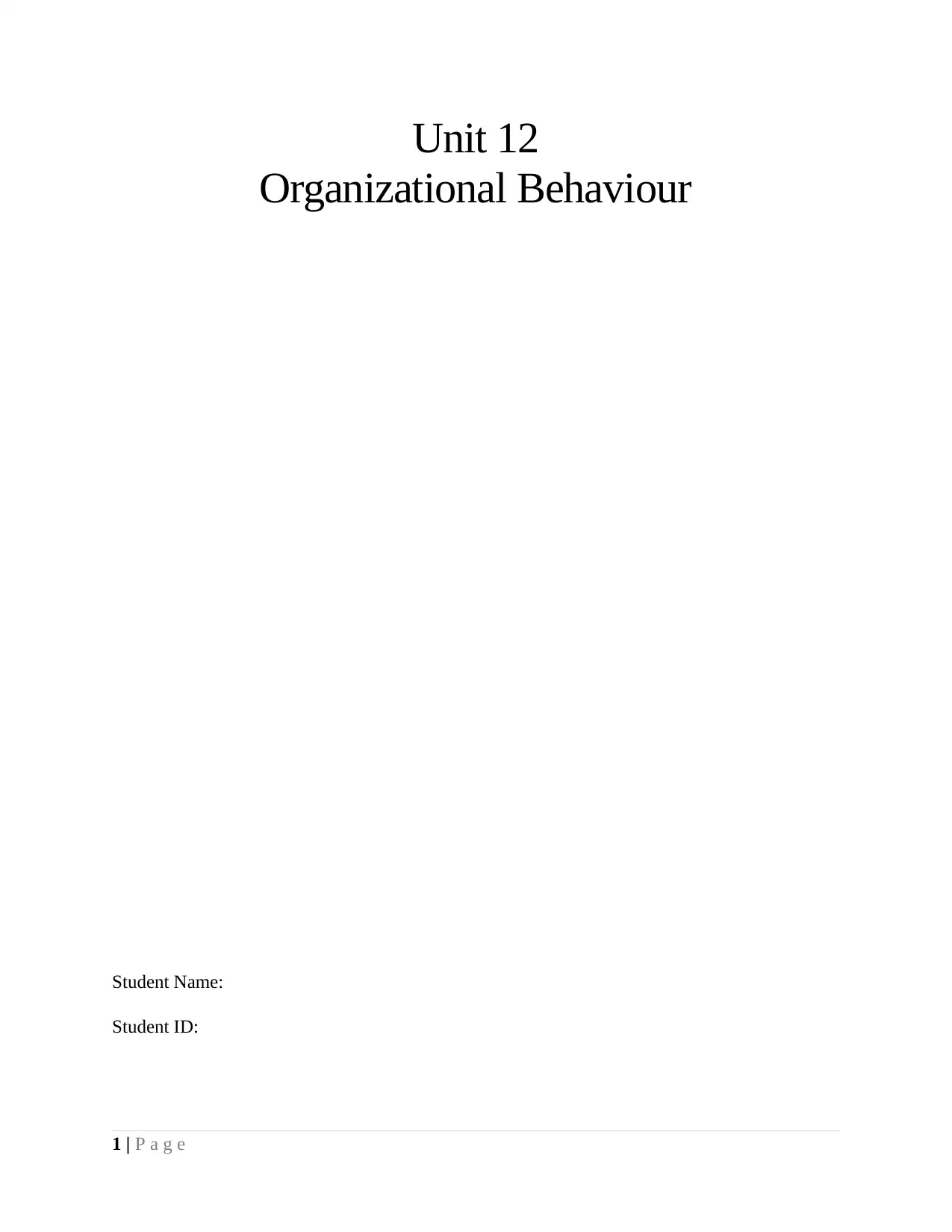
Unit 12
Organizational Behaviour
Student Name:
Student ID:
1 | P a g e
Organizational Behaviour
Student Name:
Student ID:
1 | P a g e
Secure Best Marks with AI Grader
Need help grading? Try our AI Grader for instant feedback on your assignments.

Table of Contents
Introduction:....................................................................................................................................4
LO1:.................................................................................................................................................5
1.1 Organization’s culture, politics, and power & their influence on individual and team
behavior and performance:..........................................................................................................5
1.1.1 Effect of organizational culture:.....................................................................................5
1.1.2 Influence of Organizational Politics:..............................................................................6
1.1.3 Organizational Power influence:....................................................................................6
1.2 Analysation of the culture, politics, and power of an organization can influence individual
and team behavior and performance:...........................................................................................7
1.2.1 Influence of organizational culture on individual and team behavior............................7
1.2.2 Influence of organizational politics and power:.............................................................9
LO2:...............................................................................................................................................10
2.1 How Theories of Motivation and techniques enable effectiveness in achieving goals of the
organization:..............................................................................................................................10
2.1.1 Content Theory:............................................................................................................10
2.1.2 Process Theory:............................................................................................................12
2.2 Ways of influencing the behavior of others through the practical application of behavioral,
motivational theories & models:................................................................................................13
2.2.1 implications of the motivational theory of leadership within organizations:...............13
LO3:...............................................................................................................................................15
3.1 What makes an effective team as opposed to an ineffective team:.....................................15
3.1.1 Factors behind making the team effective or ineffective..............................................15
3.1.2 Types of Organizational Teams:...................................................................................15
3.2 Relevant team and group development theories to support the development of cooperation
within effective teams:...............................................................................................................16
2 | P a g e
Introduction:....................................................................................................................................4
LO1:.................................................................................................................................................5
1.1 Organization’s culture, politics, and power & their influence on individual and team
behavior and performance:..........................................................................................................5
1.1.1 Effect of organizational culture:.....................................................................................5
1.1.2 Influence of Organizational Politics:..............................................................................6
1.1.3 Organizational Power influence:....................................................................................6
1.2 Analysation of the culture, politics, and power of an organization can influence individual
and team behavior and performance:...........................................................................................7
1.2.1 Influence of organizational culture on individual and team behavior............................7
1.2.2 Influence of organizational politics and power:.............................................................9
LO2:...............................................................................................................................................10
2.1 How Theories of Motivation and techniques enable effectiveness in achieving goals of the
organization:..............................................................................................................................10
2.1.1 Content Theory:............................................................................................................10
2.1.2 Process Theory:............................................................................................................12
2.2 Ways of influencing the behavior of others through the practical application of behavioral,
motivational theories & models:................................................................................................13
2.2.1 implications of the motivational theory of leadership within organizations:...............13
LO3:...............................................................................................................................................15
3.1 What makes an effective team as opposed to an ineffective team:.....................................15
3.1.1 Factors behind making the team effective or ineffective..............................................15
3.1.2 Types of Organizational Teams:...................................................................................15
3.2 Relevant team and group development theories to support the development of cooperation
within effective teams:...............................................................................................................16
2 | P a g e
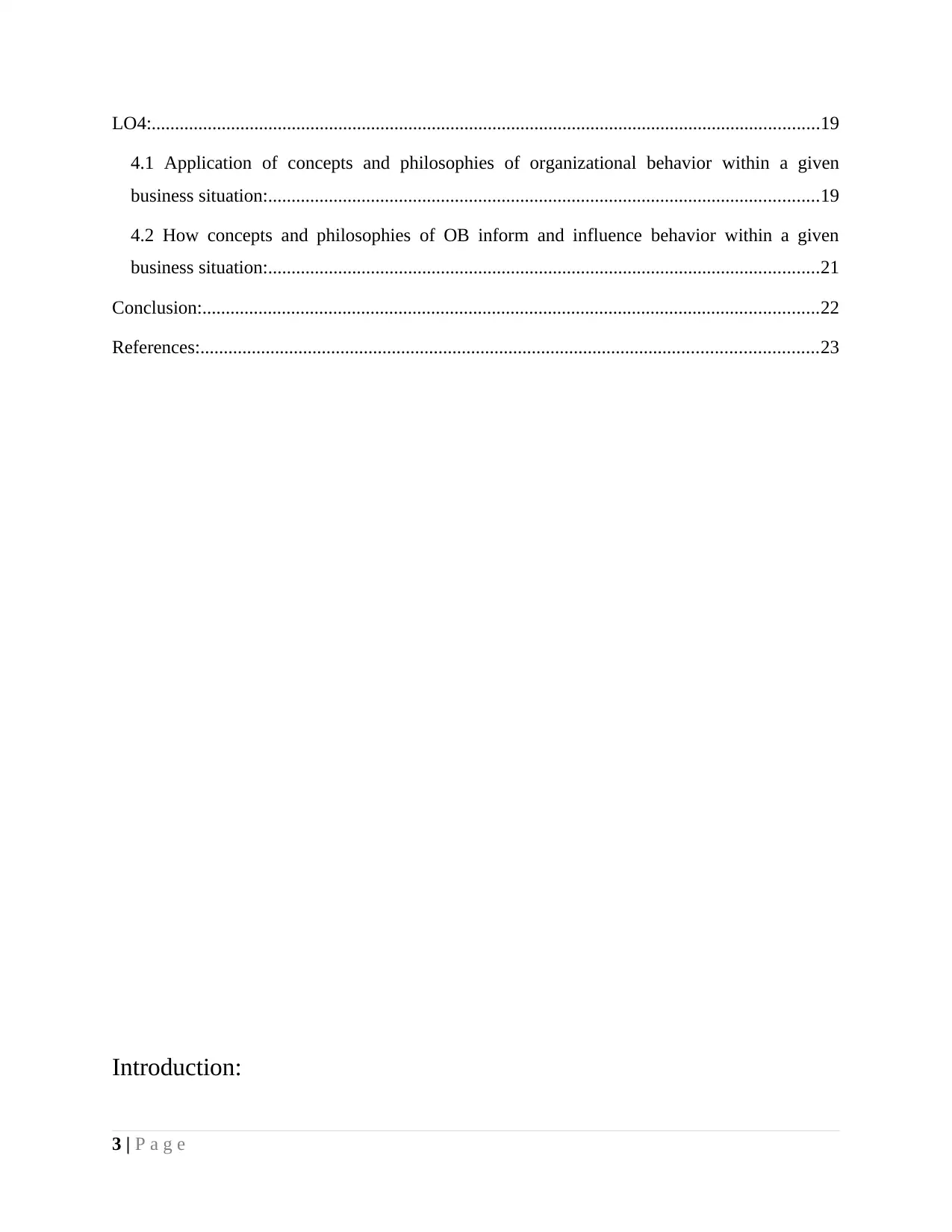
LO4:...............................................................................................................................................19
4.1 Application of concepts and philosophies of organizational behavior within a given
business situation:......................................................................................................................19
4.2 How concepts and philosophies of OB inform and influence behavior within a given
business situation:......................................................................................................................21
Conclusion:....................................................................................................................................22
References:....................................................................................................................................23
Introduction:
3 | P a g e
4.1 Application of concepts and philosophies of organizational behavior within a given
business situation:......................................................................................................................19
4.2 How concepts and philosophies of OB inform and influence behavior within a given
business situation:......................................................................................................................21
Conclusion:....................................................................................................................................22
References:....................................................................................................................................23
Introduction:
3 | P a g e
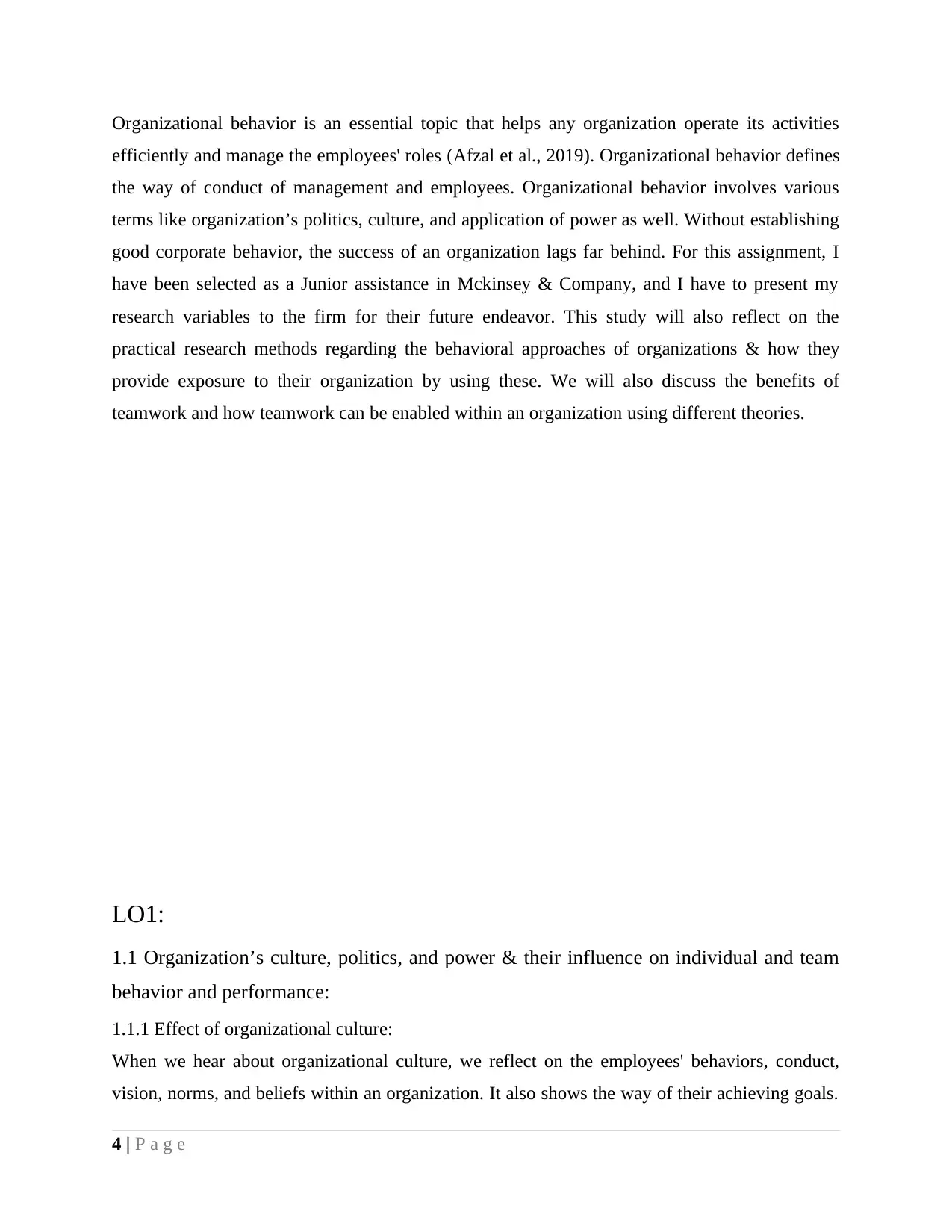
Organizational behavior is an essential topic that helps any organization operate its activities
efficiently and manage the employees' roles (Afzal et al., 2019). Organizational behavior defines
the way of conduct of management and employees. Organizational behavior involves various
terms like organization’s politics, culture, and application of power as well. Without establishing
good corporate behavior, the success of an organization lags far behind. For this assignment, I
have been selected as a Junior assistance in Mckinsey & Company, and I have to present my
research variables to the firm for their future endeavor. This study will also reflect on the
practical research methods regarding the behavioral approaches of organizations & how they
provide exposure to their organization by using these. We will also discuss the benefits of
teamwork and how teamwork can be enabled within an organization using different theories.
LO1:
1.1 Organization’s culture, politics, and power & their influence on individual and team
behavior and performance:
1.1.1 Effect of organizational culture:
When we hear about organizational culture, we reflect on the employees' behaviors, conduct,
vision, norms, and beliefs within an organization. It also shows the way of their achieving goals.
4 | P a g e
efficiently and manage the employees' roles (Afzal et al., 2019). Organizational behavior defines
the way of conduct of management and employees. Organizational behavior involves various
terms like organization’s politics, culture, and application of power as well. Without establishing
good corporate behavior, the success of an organization lags far behind. For this assignment, I
have been selected as a Junior assistance in Mckinsey & Company, and I have to present my
research variables to the firm for their future endeavor. This study will also reflect on the
practical research methods regarding the behavioral approaches of organizations & how they
provide exposure to their organization by using these. We will also discuss the benefits of
teamwork and how teamwork can be enabled within an organization using different theories.
LO1:
1.1 Organization’s culture, politics, and power & their influence on individual and team
behavior and performance:
1.1.1 Effect of organizational culture:
When we hear about organizational culture, we reflect on the employees' behaviors, conduct,
vision, norms, and beliefs within an organization. It also shows the way of their achieving goals.
4 | P a g e
Secure Best Marks with AI Grader
Need help grading? Try our AI Grader for instant feedback on your assignments.
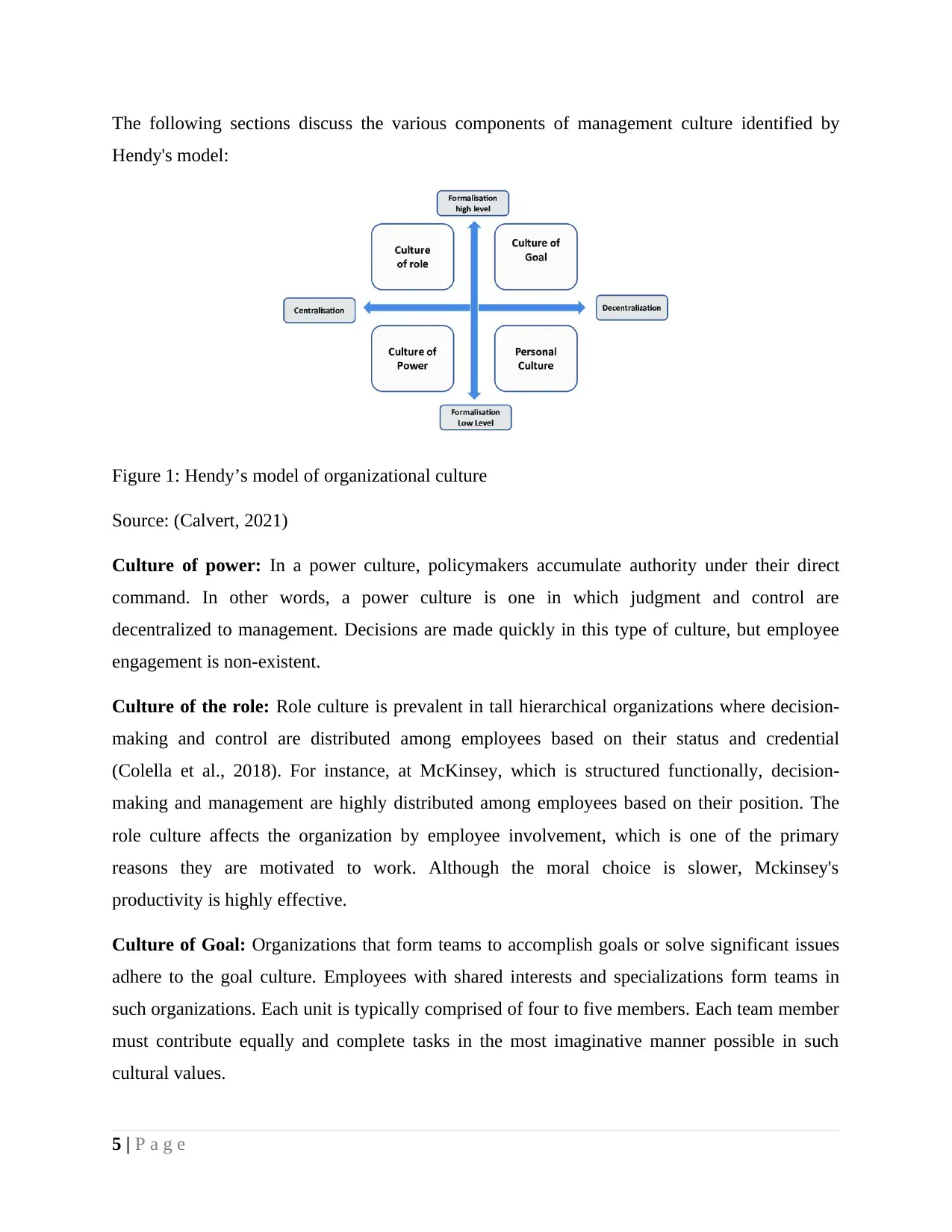
The following sections discuss the various components of management culture identified by
Hendy's model:
Figure 1: Hendy’s model of organizational culture
Source: (Calvert, 2021)
Culture of power: In a power culture, policymakers accumulate authority under their direct
command. In other words, a power culture is one in which judgment and control are
decentralized to management. Decisions are made quickly in this type of culture, but employee
engagement is non-existent.
Culture of the role: Role culture is prevalent in tall hierarchical organizations where decision-
making and control are distributed among employees based on their status and credential
(Colella et al., 2018). For instance, at McKinsey, which is structured functionally, decision-
making and management are highly distributed among employees based on their position. The
role culture affects the organization by employee involvement, which is one of the primary
reasons they are motivated to work. Although the moral choice is slower, Mckinsey's
productivity is highly effective.
Culture of Goal: Organizations that form teams to accomplish goals or solve significant issues
adhere to the goal culture. Employees with shared interests and specializations form teams in
such organizations. Each unit is typically comprised of four to five members. Each team member
must contribute equally and complete tasks in the most imaginative manner possible in such
cultural values.
5 | P a g e
Hendy's model:
Figure 1: Hendy’s model of organizational culture
Source: (Calvert, 2021)
Culture of power: In a power culture, policymakers accumulate authority under their direct
command. In other words, a power culture is one in which judgment and control are
decentralized to management. Decisions are made quickly in this type of culture, but employee
engagement is non-existent.
Culture of the role: Role culture is prevalent in tall hierarchical organizations where decision-
making and control are distributed among employees based on their status and credential
(Colella et al., 2018). For instance, at McKinsey, which is structured functionally, decision-
making and management are highly distributed among employees based on their position. The
role culture affects the organization by employee involvement, which is one of the primary
reasons they are motivated to work. Although the moral choice is slower, Mckinsey's
productivity is highly effective.
Culture of Goal: Organizations that form teams to accomplish goals or solve significant issues
adhere to the goal culture. Employees with shared interests and specializations form teams in
such organizations. Each unit is typically comprised of four to five members. Each team member
must contribute equally and complete tasks in the most imaginative manner possible in such
cultural values.
5 | P a g e

Unique culture: There are many organizations where the employees feel superior to the
organization. They believe that they are more valuable to the organization than that organization.
This type of culture is also known as dubbed person culture. These types of industries are self-
centered and much concerned about their activities than the organization (Hiriyappa, 2017). In
such a culture, The organization lagged and starts suffering in the long run. The employees have
no inner connection or emotional attachment with their colleagues or office. They go there to
earn money. McKinsey does not follow this culture.
1.1.2 Influence of Organizational Politics:
Organizational politics define individuals' power and approaches. Corporate politics can have a
variety of beneficial effects on an organization. For instance, the existence of diplomacy at
McKinsey & Group via union movement and workplace politics positively impacts employee
empowerment (Natvig & Stark, 2016). Trade unions protect employee rights, equal pay, equity,
and justice. The positive influence of politics on employers persuades them to improve employee
wellbeing and working conditions. For instance, politically influential employers in my
organization engage in various development activities to enhance organizational performance.
On the other hand, the negative influence can result in corruption and abuse for personal gain,
criminal acts, and favoritism.
1.1.3 Organizational Power influence:
The organization's power is the visible manifestation of its culture and politics. At Mckinsey, the
leadership role persuades control to be allocated based on the employee's position.
6 | P a g e
organization. They believe that they are more valuable to the organization than that organization.
This type of culture is also known as dubbed person culture. These types of industries are self-
centered and much concerned about their activities than the organization (Hiriyappa, 2017). In
such a culture, The organization lagged and starts suffering in the long run. The employees have
no inner connection or emotional attachment with their colleagues or office. They go there to
earn money. McKinsey does not follow this culture.
1.1.2 Influence of Organizational Politics:
Organizational politics define individuals' power and approaches. Corporate politics can have a
variety of beneficial effects on an organization. For instance, the existence of diplomacy at
McKinsey & Group via union movement and workplace politics positively impacts employee
empowerment (Natvig & Stark, 2016). Trade unions protect employee rights, equal pay, equity,
and justice. The positive influence of politics on employers persuades them to improve employee
wellbeing and working conditions. For instance, politically influential employers in my
organization engage in various development activities to enhance organizational performance.
On the other hand, the negative influence can result in corruption and abuse for personal gain,
criminal acts, and favoritism.
1.1.3 Organizational Power influence:
The organization's power is the visible manifestation of its culture and politics. At Mckinsey, the
leadership role persuades control to be allocated based on the employee's position.
6 | P a g e
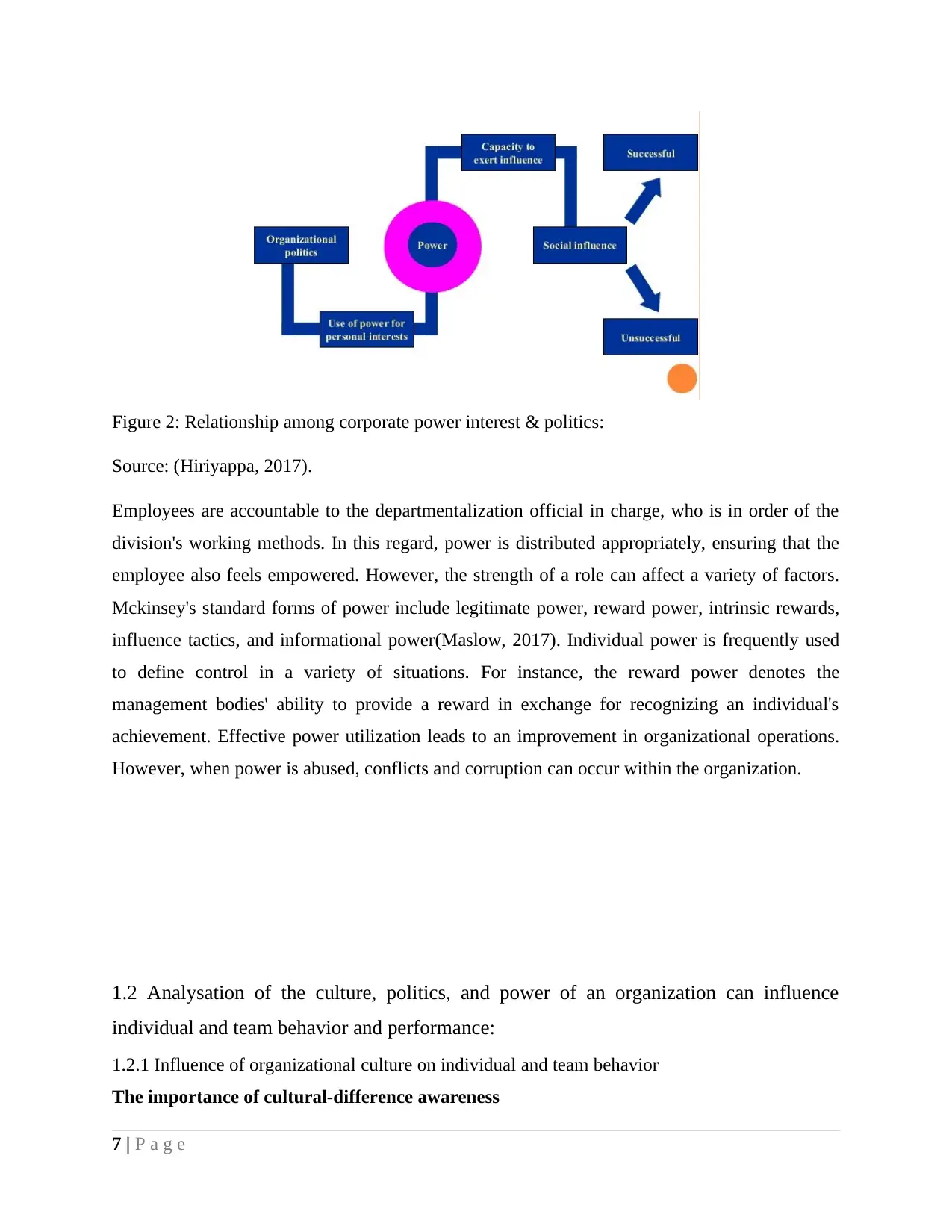
Figure 2: Relationship among corporate power interest & politics:
Source: (Hiriyappa, 2017).
Employees are accountable to the departmentalization official in charge, who is in order of the
division's working methods. In this regard, power is distributed appropriately, ensuring that the
employee also feels empowered. However, the strength of a role can affect a variety of factors.
Mckinsey's standard forms of power include legitimate power, reward power, intrinsic rewards,
influence tactics, and informational power(Maslow, 2017). Individual power is frequently used
to define control in a variety of situations. For instance, the reward power denotes the
management bodies' ability to provide a reward in exchange for recognizing an individual's
achievement. Effective power utilization leads to an improvement in organizational operations.
However, when power is abused, conflicts and corruption can occur within the organization.
1.2 Analysation of the culture, politics, and power of an organization can influence
individual and team behavior and performance:
1.2.1 Influence of organizational culture on individual and team behavior
The importance of cultural-difference awareness
7 | P a g e
Source: (Hiriyappa, 2017).
Employees are accountable to the departmentalization official in charge, who is in order of the
division's working methods. In this regard, power is distributed appropriately, ensuring that the
employee also feels empowered. However, the strength of a role can affect a variety of factors.
Mckinsey's standard forms of power include legitimate power, reward power, intrinsic rewards,
influence tactics, and informational power(Maslow, 2017). Individual power is frequently used
to define control in a variety of situations. For instance, the reward power denotes the
management bodies' ability to provide a reward in exchange for recognizing an individual's
achievement. Effective power utilization leads to an improvement in organizational operations.
However, when power is abused, conflicts and corruption can occur within the organization.
1.2 Analysation of the culture, politics, and power of an organization can influence
individual and team behavior and performance:
1.2.1 Influence of organizational culture on individual and team behavior
The importance of cultural-difference awareness
7 | P a g e
Paraphrase This Document
Need a fresh take? Get an instant paraphrase of this document with our AI Paraphraser
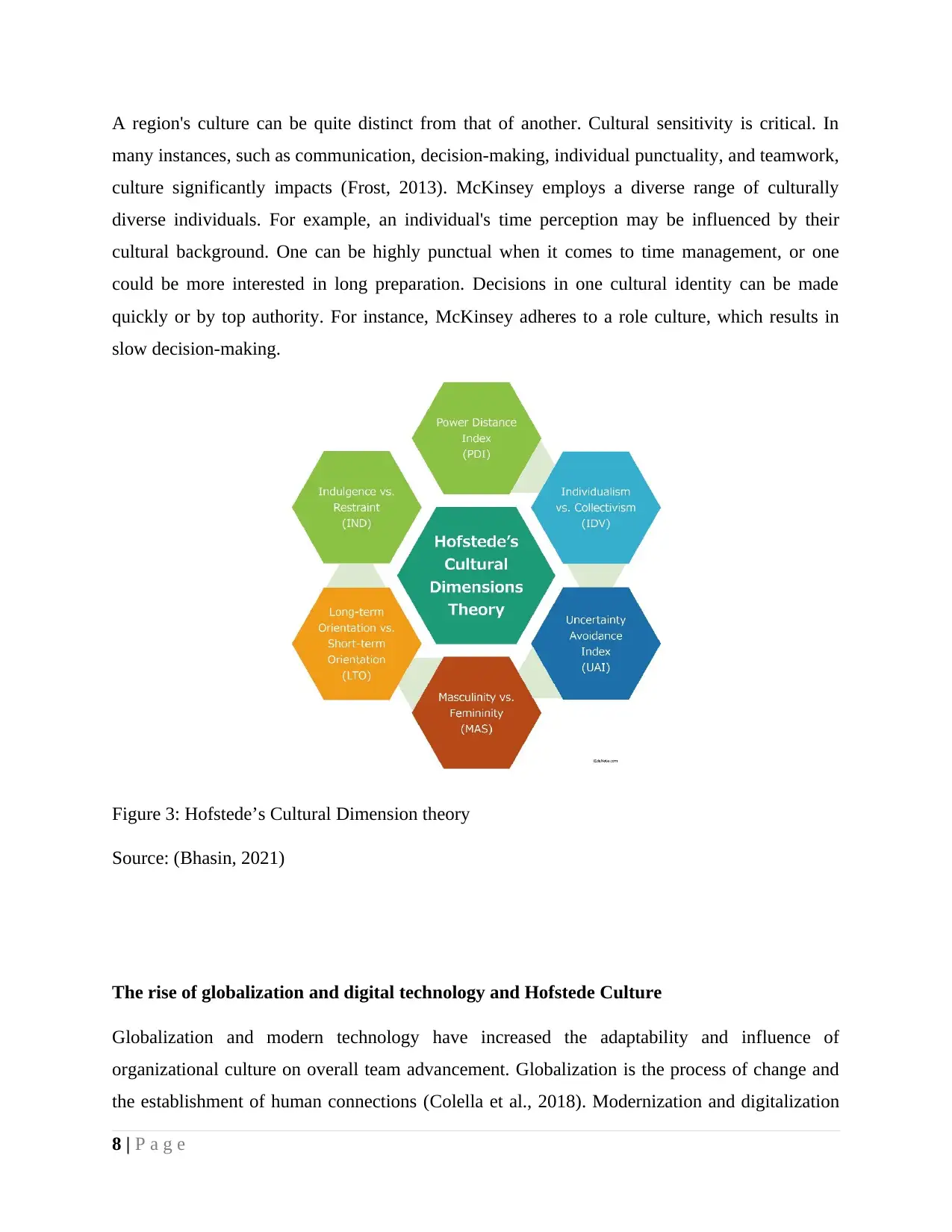
A region's culture can be quite distinct from that of another. Cultural sensitivity is critical. In
many instances, such as communication, decision-making, individual punctuality, and teamwork,
culture significantly impacts (Frost, 2013). McKinsey employs a diverse range of culturally
diverse individuals. For example, an individual's time perception may be influenced by their
cultural background. One can be highly punctual when it comes to time management, or one
could be more interested in long preparation. Decisions in one cultural identity can be made
quickly or by top authority. For instance, McKinsey adheres to a role culture, which results in
slow decision-making.
Figure 3: Hofstede’s Cultural Dimension theory
Source: (Bhasin, 2021)
The rise of globalization and digital technology and Hofstede Culture
Globalization and modern technology have increased the adaptability and influence of
organizational culture on overall team advancement. Globalization is the process of change and
the establishment of human connections (Colella et al., 2018). Modernization and digitalization
8 | P a g e
many instances, such as communication, decision-making, individual punctuality, and teamwork,
culture significantly impacts (Frost, 2013). McKinsey employs a diverse range of culturally
diverse individuals. For example, an individual's time perception may be influenced by their
cultural background. One can be highly punctual when it comes to time management, or one
could be more interested in long preparation. Decisions in one cultural identity can be made
quickly or by top authority. For instance, McKinsey adheres to a role culture, which results in
slow decision-making.
Figure 3: Hofstede’s Cultural Dimension theory
Source: (Bhasin, 2021)
The rise of globalization and digital technology and Hofstede Culture
Globalization and modern technology have increased the adaptability and influence of
organizational culture on overall team advancement. Globalization is the process of change and
the establishment of human connections (Colella et al., 2018). Modernization and digitalization
8 | P a g e
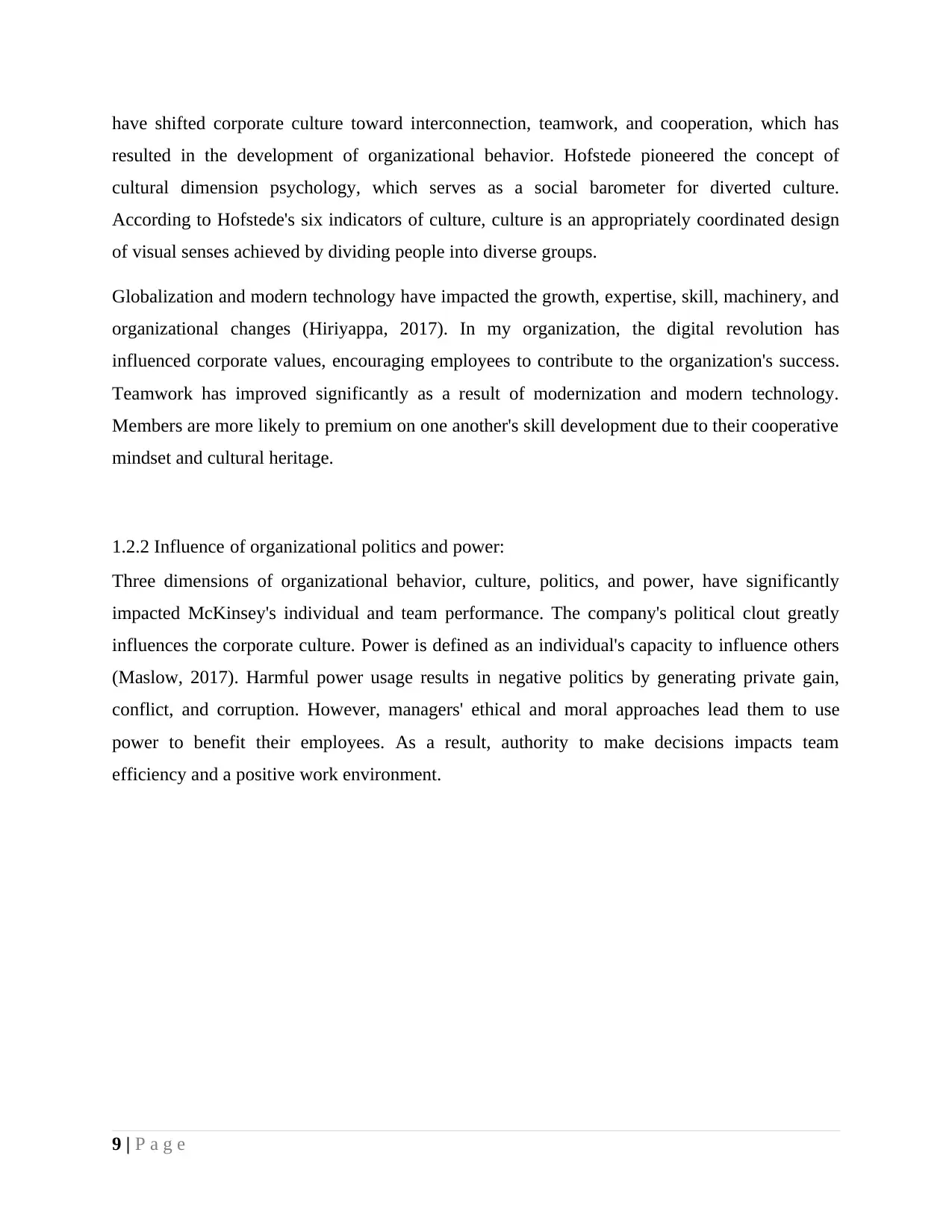
have shifted corporate culture toward interconnection, teamwork, and cooperation, which has
resulted in the development of organizational behavior. Hofstede pioneered the concept of
cultural dimension psychology, which serves as a social barometer for diverted culture.
According to Hofstede's six indicators of culture, culture is an appropriately coordinated design
of visual senses achieved by dividing people into diverse groups.
Globalization and modern technology have impacted the growth, expertise, skill, machinery, and
organizational changes (Hiriyappa, 2017). In my organization, the digital revolution has
influenced corporate values, encouraging employees to contribute to the organization's success.
Teamwork has improved significantly as a result of modernization and modern technology.
Members are more likely to premium on one another's skill development due to their cooperative
mindset and cultural heritage.
1.2.2 Influence of organizational politics and power:
Three dimensions of organizational behavior, culture, politics, and power, have significantly
impacted McKinsey's individual and team performance. The company's political clout greatly
influences the corporate culture. Power is defined as an individual's capacity to influence others
(Maslow, 2017). Harmful power usage results in negative politics by generating private gain,
conflict, and corruption. However, managers' ethical and moral approaches lead them to use
power to benefit their employees. As a result, authority to make decisions impacts team
efficiency and a positive work environment.
9 | P a g e
resulted in the development of organizational behavior. Hofstede pioneered the concept of
cultural dimension psychology, which serves as a social barometer for diverted culture.
According to Hofstede's six indicators of culture, culture is an appropriately coordinated design
of visual senses achieved by dividing people into diverse groups.
Globalization and modern technology have impacted the growth, expertise, skill, machinery, and
organizational changes (Hiriyappa, 2017). In my organization, the digital revolution has
influenced corporate values, encouraging employees to contribute to the organization's success.
Teamwork has improved significantly as a result of modernization and modern technology.
Members are more likely to premium on one another's skill development due to their cooperative
mindset and cultural heritage.
1.2.2 Influence of organizational politics and power:
Three dimensions of organizational behavior, culture, politics, and power, have significantly
impacted McKinsey's individual and team performance. The company's political clout greatly
influences the corporate culture. Power is defined as an individual's capacity to influence others
(Maslow, 2017). Harmful power usage results in negative politics by generating private gain,
conflict, and corruption. However, managers' ethical and moral approaches lead them to use
power to benefit their employees. As a result, authority to make decisions impacts team
efficiency and a positive work environment.
9 | P a g e
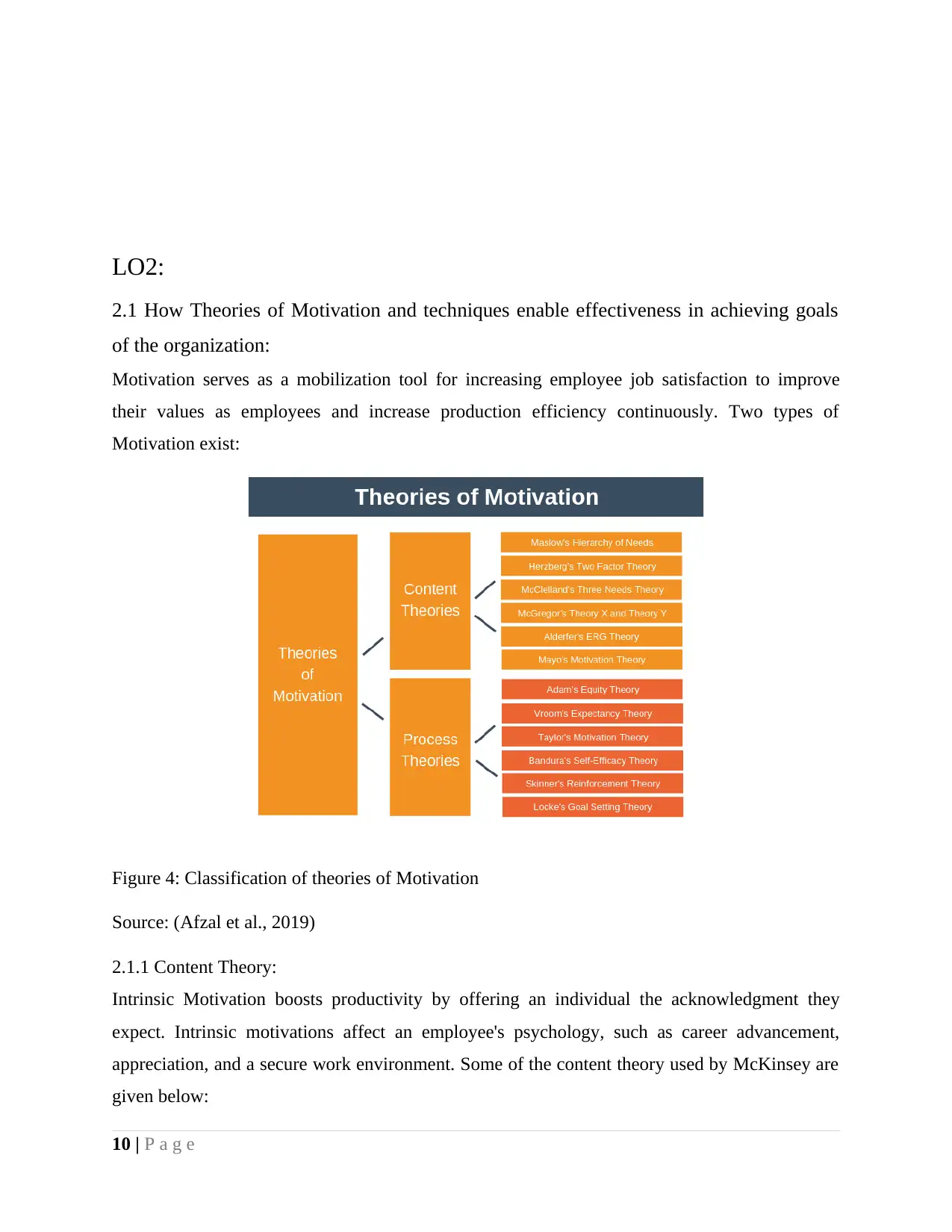
LO2:
2.1 How Theories of Motivation and techniques enable effectiveness in achieving goals
of the organization:
Motivation serves as a mobilization tool for increasing employee job satisfaction to improve
their values as employees and increase production efficiency continuously. Two types of
Motivation exist:
Figure 4: Classification of theories of Motivation
Source: (Afzal et al., 2019)
2.1.1 Content Theory:
Intrinsic Motivation boosts productivity by offering an individual the acknowledgment they
expect. Intrinsic motivations affect an employee's psychology, such as career advancement,
appreciation, and a secure work environment. Some of the content theory used by McKinsey are
given below:
10 | P a g e
2.1 How Theories of Motivation and techniques enable effectiveness in achieving goals
of the organization:
Motivation serves as a mobilization tool for increasing employee job satisfaction to improve
their values as employees and increase production efficiency continuously. Two types of
Motivation exist:
Figure 4: Classification of theories of Motivation
Source: (Afzal et al., 2019)
2.1.1 Content Theory:
Intrinsic Motivation boosts productivity by offering an individual the acknowledgment they
expect. Intrinsic motivations affect an employee's psychology, such as career advancement,
appreciation, and a secure work environment. Some of the content theory used by McKinsey are
given below:
10 | P a g e
Secure Best Marks with AI Grader
Need help grading? Try our AI Grader for instant feedback on your assignments.
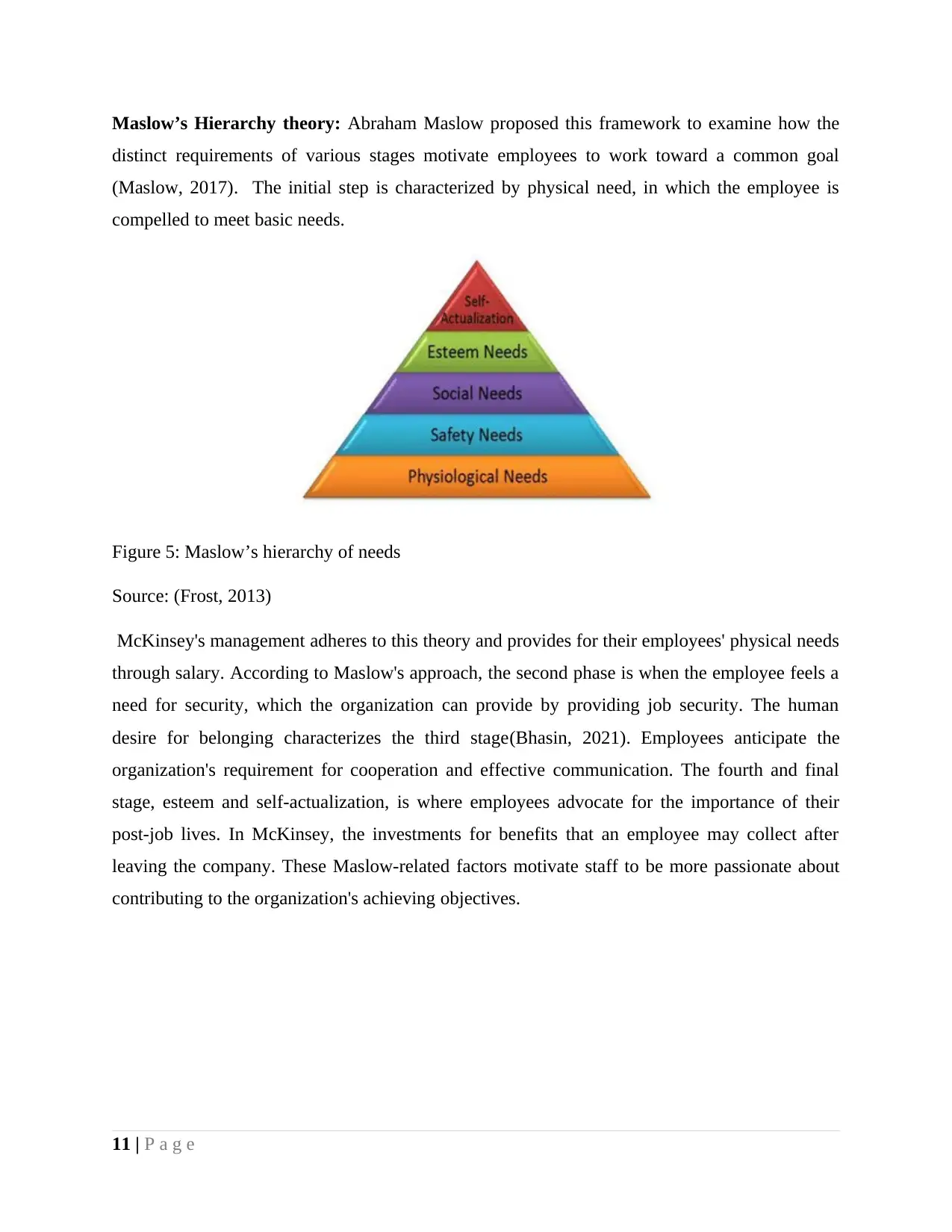
Maslow’s Hierarchy theory: Abraham Maslow proposed this framework to examine how the
distinct requirements of various stages motivate employees to work toward a common goal
(Maslow, 2017). The initial step is characterized by physical need, in which the employee is
compelled to meet basic needs.
Figure 5: Maslow’s hierarchy of needs
Source: (Frost, 2013)
McKinsey's management adheres to this theory and provides for their employees' physical needs
through salary. According to Maslow's approach, the second phase is when the employee feels a
need for security, which the organization can provide by providing job security. The human
desire for belonging characterizes the third stage(Bhasin, 2021). Employees anticipate the
organization's requirement for cooperation and effective communication. The fourth and final
stage, esteem and self-actualization, is where employees advocate for the importance of their
post-job lives. In McKinsey, the investments for benefits that an employee may collect after
leaving the company. These Maslow-related factors motivate staff to be more passionate about
contributing to the organization's achieving objectives.
11 | P a g e
distinct requirements of various stages motivate employees to work toward a common goal
(Maslow, 2017). The initial step is characterized by physical need, in which the employee is
compelled to meet basic needs.
Figure 5: Maslow’s hierarchy of needs
Source: (Frost, 2013)
McKinsey's management adheres to this theory and provides for their employees' physical needs
through salary. According to Maslow's approach, the second phase is when the employee feels a
need for security, which the organization can provide by providing job security. The human
desire for belonging characterizes the third stage(Bhasin, 2021). Employees anticipate the
organization's requirement for cooperation and effective communication. The fourth and final
stage, esteem and self-actualization, is where employees advocate for the importance of their
post-job lives. In McKinsey, the investments for benefits that an employee may collect after
leaving the company. These Maslow-related factors motivate staff to be more passionate about
contributing to the organization's achieving objectives.
11 | P a g e
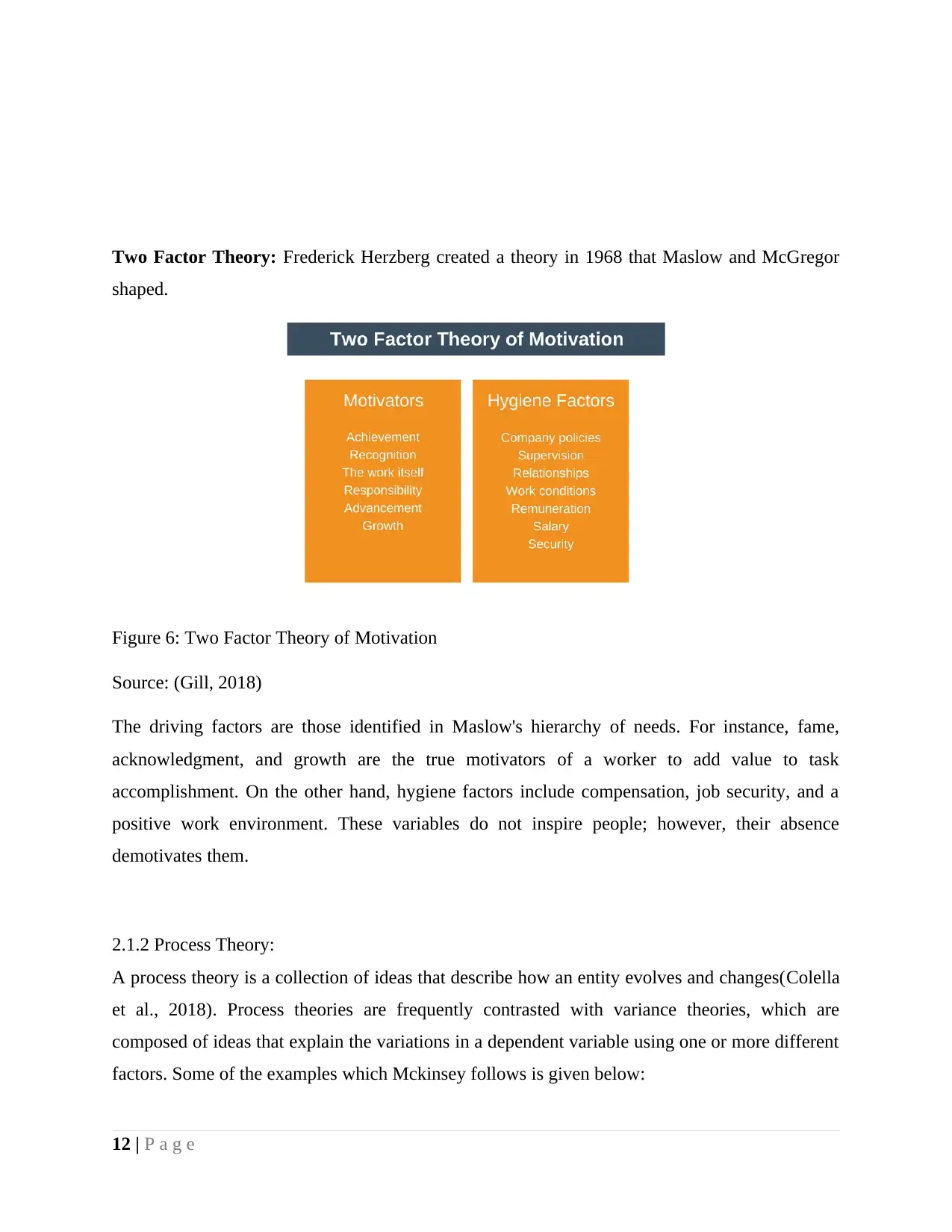
Two Factor Theory: Frederick Herzberg created a theory in 1968 that Maslow and McGregor
shaped.
Figure 6: Two Factor Theory of Motivation
Source: (Gill, 2018)
The driving factors are those identified in Maslow's hierarchy of needs. For instance, fame,
acknowledgment, and growth are the true motivators of a worker to add value to task
accomplishment. On the other hand, hygiene factors include compensation, job security, and a
positive work environment. These variables do not inspire people; however, their absence
demotivates them.
2.1.2 Process Theory:
A process theory is a collection of ideas that describe how an entity evolves and changes(Colella
et al., 2018). Process theories are frequently contrasted with variance theories, which are
composed of ideas that explain the variations in a dependent variable using one or more different
factors. Some of the examples which Mckinsey follows is given below:
12 | P a g e
shaped.
Figure 6: Two Factor Theory of Motivation
Source: (Gill, 2018)
The driving factors are those identified in Maslow's hierarchy of needs. For instance, fame,
acknowledgment, and growth are the true motivators of a worker to add value to task
accomplishment. On the other hand, hygiene factors include compensation, job security, and a
positive work environment. These variables do not inspire people; however, their absence
demotivates them.
2.1.2 Process Theory:
A process theory is a collection of ideas that describe how an entity evolves and changes(Colella
et al., 2018). Process theories are frequently contrasted with variance theories, which are
composed of ideas that explain the variations in a dependent variable using one or more different
factors. Some of the examples which Mckinsey follows is given below:
12 | P a g e
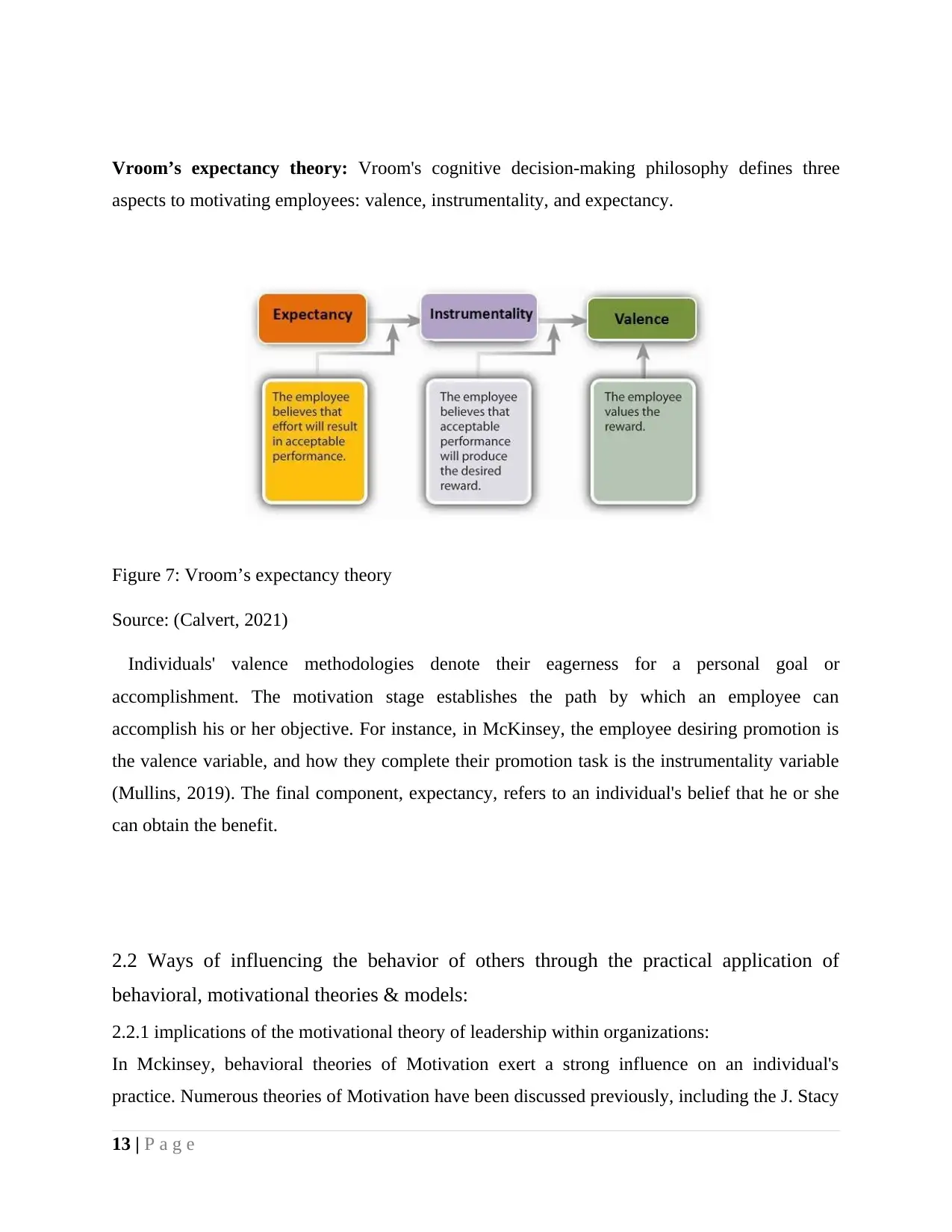
Vroom’s expectancy theory: Vroom's cognitive decision-making philosophy defines three
aspects to motivating employees: valence, instrumentality, and expectancy.
Figure 7: Vroom’s expectancy theory
Source: (Calvert, 2021)
Individuals' valence methodologies denote their eagerness for a personal goal or
accomplishment. The motivation stage establishes the path by which an employee can
accomplish his or her objective. For instance, in McKinsey, the employee desiring promotion is
the valence variable, and how they complete their promotion task is the instrumentality variable
(Mullins, 2019). The final component, expectancy, refers to an individual's belief that he or she
can obtain the benefit.
2.2 Ways of influencing the behavior of others through the practical application of
behavioral, motivational theories & models:
2.2.1 implications of the motivational theory of leadership within organizations:
In Mckinsey, behavioral theories of Motivation exert a strong influence on an individual's
practice. Numerous theories of Motivation have been discussed previously, including the J. Stacy
13 | P a g e
aspects to motivating employees: valence, instrumentality, and expectancy.
Figure 7: Vroom’s expectancy theory
Source: (Calvert, 2021)
Individuals' valence methodologies denote their eagerness for a personal goal or
accomplishment. The motivation stage establishes the path by which an employee can
accomplish his or her objective. For instance, in McKinsey, the employee desiring promotion is
the valence variable, and how they complete their promotion task is the instrumentality variable
(Mullins, 2019). The final component, expectancy, refers to an individual's belief that he or she
can obtain the benefit.
2.2 Ways of influencing the behavior of others through the practical application of
behavioral, motivational theories & models:
2.2.1 implications of the motivational theory of leadership within organizations:
In Mckinsey, behavioral theories of Motivation exert a strong influence on an individual's
practice. Numerous theories of Motivation have been discussed previously, including the J. Stacy
13 | P a g e
Paraphrase This Document
Need a fresh take? Get an instant paraphrase of this document with our AI Paraphraser
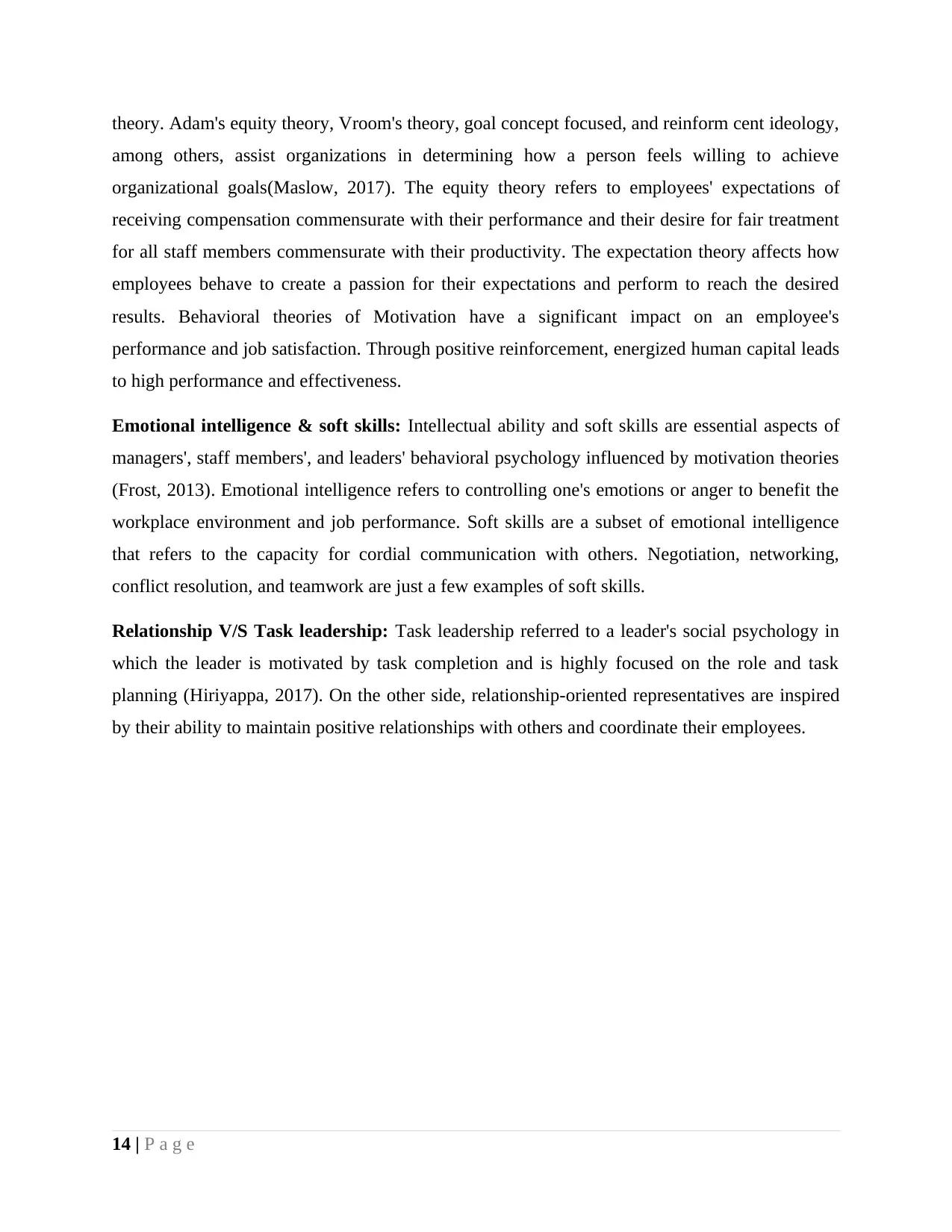
theory. Adam's equity theory, Vroom's theory, goal concept focused, and reinform cent ideology,
among others, assist organizations in determining how a person feels willing to achieve
organizational goals(Maslow, 2017). The equity theory refers to employees' expectations of
receiving compensation commensurate with their performance and their desire for fair treatment
for all staff members commensurate with their productivity. The expectation theory affects how
employees behave to create a passion for their expectations and perform to reach the desired
results. Behavioral theories of Motivation have a significant impact on an employee's
performance and job satisfaction. Through positive reinforcement, energized human capital leads
to high performance and effectiveness.
Emotional intelligence & soft skills: Intellectual ability and soft skills are essential aspects of
managers', staff members', and leaders' behavioral psychology influenced by motivation theories
(Frost, 2013). Emotional intelligence refers to controlling one's emotions or anger to benefit the
workplace environment and job performance. Soft skills are a subset of emotional intelligence
that refers to the capacity for cordial communication with others. Negotiation, networking,
conflict resolution, and teamwork are just a few examples of soft skills.
Relationship V/S Task leadership: Task leadership referred to a leader's social psychology in
which the leader is motivated by task completion and is highly focused on the role and task
planning (Hiriyappa, 2017). On the other side, relationship-oriented representatives are inspired
by their ability to maintain positive relationships with others and coordinate their employees.
14 | P a g e
among others, assist organizations in determining how a person feels willing to achieve
organizational goals(Maslow, 2017). The equity theory refers to employees' expectations of
receiving compensation commensurate with their performance and their desire for fair treatment
for all staff members commensurate with their productivity. The expectation theory affects how
employees behave to create a passion for their expectations and perform to reach the desired
results. Behavioral theories of Motivation have a significant impact on an employee's
performance and job satisfaction. Through positive reinforcement, energized human capital leads
to high performance and effectiveness.
Emotional intelligence & soft skills: Intellectual ability and soft skills are essential aspects of
managers', staff members', and leaders' behavioral psychology influenced by motivation theories
(Frost, 2013). Emotional intelligence refers to controlling one's emotions or anger to benefit the
workplace environment and job performance. Soft skills are a subset of emotional intelligence
that refers to the capacity for cordial communication with others. Negotiation, networking,
conflict resolution, and teamwork are just a few examples of soft skills.
Relationship V/S Task leadership: Task leadership referred to a leader's social psychology in
which the leader is motivated by task completion and is highly focused on the role and task
planning (Hiriyappa, 2017). On the other side, relationship-oriented representatives are inspired
by their ability to maintain positive relationships with others and coordinate their employees.
14 | P a g e
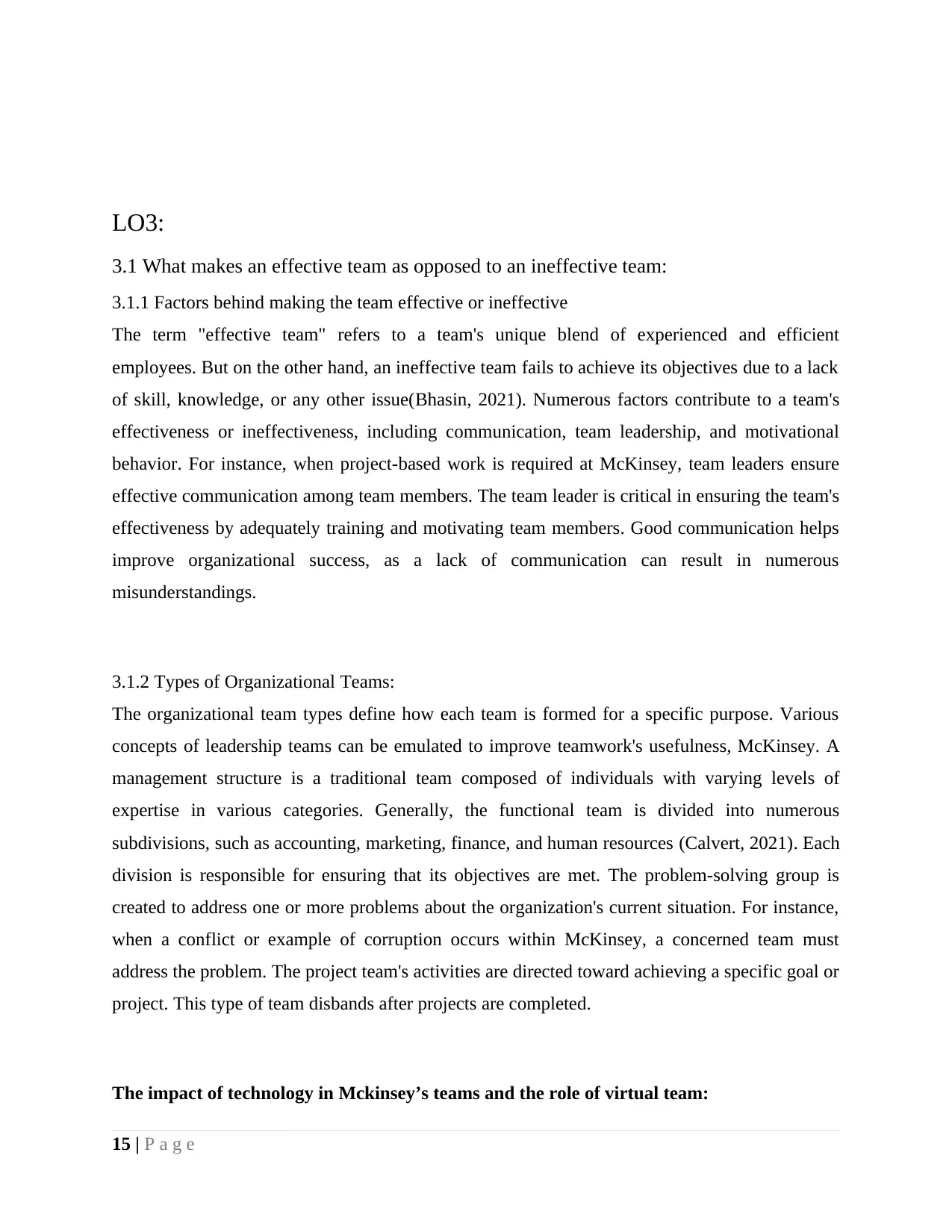
LO3:
3.1 What makes an effective team as opposed to an ineffective team:
3.1.1 Factors behind making the team effective or ineffective
The term "effective team" refers to a team's unique blend of experienced and efficient
employees. But on the other hand, an ineffective team fails to achieve its objectives due to a lack
of skill, knowledge, or any other issue(Bhasin, 2021). Numerous factors contribute to a team's
effectiveness or ineffectiveness, including communication, team leadership, and motivational
behavior. For instance, when project-based work is required at McKinsey, team leaders ensure
effective communication among team members. The team leader is critical in ensuring the team's
effectiveness by adequately training and motivating team members. Good communication helps
improve organizational success, as a lack of communication can result in numerous
misunderstandings.
3.1.2 Types of Organizational Teams:
The organizational team types define how each team is formed for a specific purpose. Various
concepts of leadership teams can be emulated to improve teamwork's usefulness, McKinsey. A
management structure is a traditional team composed of individuals with varying levels of
expertise in various categories. Generally, the functional team is divided into numerous
subdivisions, such as accounting, marketing, finance, and human resources (Calvert, 2021). Each
division is responsible for ensuring that its objectives are met. The problem-solving group is
created to address one or more problems about the organization's current situation. For instance,
when a conflict or example of corruption occurs within McKinsey, a concerned team must
address the problem. The project team's activities are directed toward achieving a specific goal or
project. This type of team disbands after projects are completed.
The impact of technology in Mckinsey’s teams and the role of virtual team:
15 | P a g e
3.1 What makes an effective team as opposed to an ineffective team:
3.1.1 Factors behind making the team effective or ineffective
The term "effective team" refers to a team's unique blend of experienced and efficient
employees. But on the other hand, an ineffective team fails to achieve its objectives due to a lack
of skill, knowledge, or any other issue(Bhasin, 2021). Numerous factors contribute to a team's
effectiveness or ineffectiveness, including communication, team leadership, and motivational
behavior. For instance, when project-based work is required at McKinsey, team leaders ensure
effective communication among team members. The team leader is critical in ensuring the team's
effectiveness by adequately training and motivating team members. Good communication helps
improve organizational success, as a lack of communication can result in numerous
misunderstandings.
3.1.2 Types of Organizational Teams:
The organizational team types define how each team is formed for a specific purpose. Various
concepts of leadership teams can be emulated to improve teamwork's usefulness, McKinsey. A
management structure is a traditional team composed of individuals with varying levels of
expertise in various categories. Generally, the functional team is divided into numerous
subdivisions, such as accounting, marketing, finance, and human resources (Calvert, 2021). Each
division is responsible for ensuring that its objectives are met. The problem-solving group is
created to address one or more problems about the organization's current situation. For instance,
when a conflict or example of corruption occurs within McKinsey, a concerned team must
address the problem. The project team's activities are directed toward achieving a specific goal or
project. This type of team disbands after projects are completed.
The impact of technology in Mckinsey’s teams and the role of virtual team:
15 | P a g e
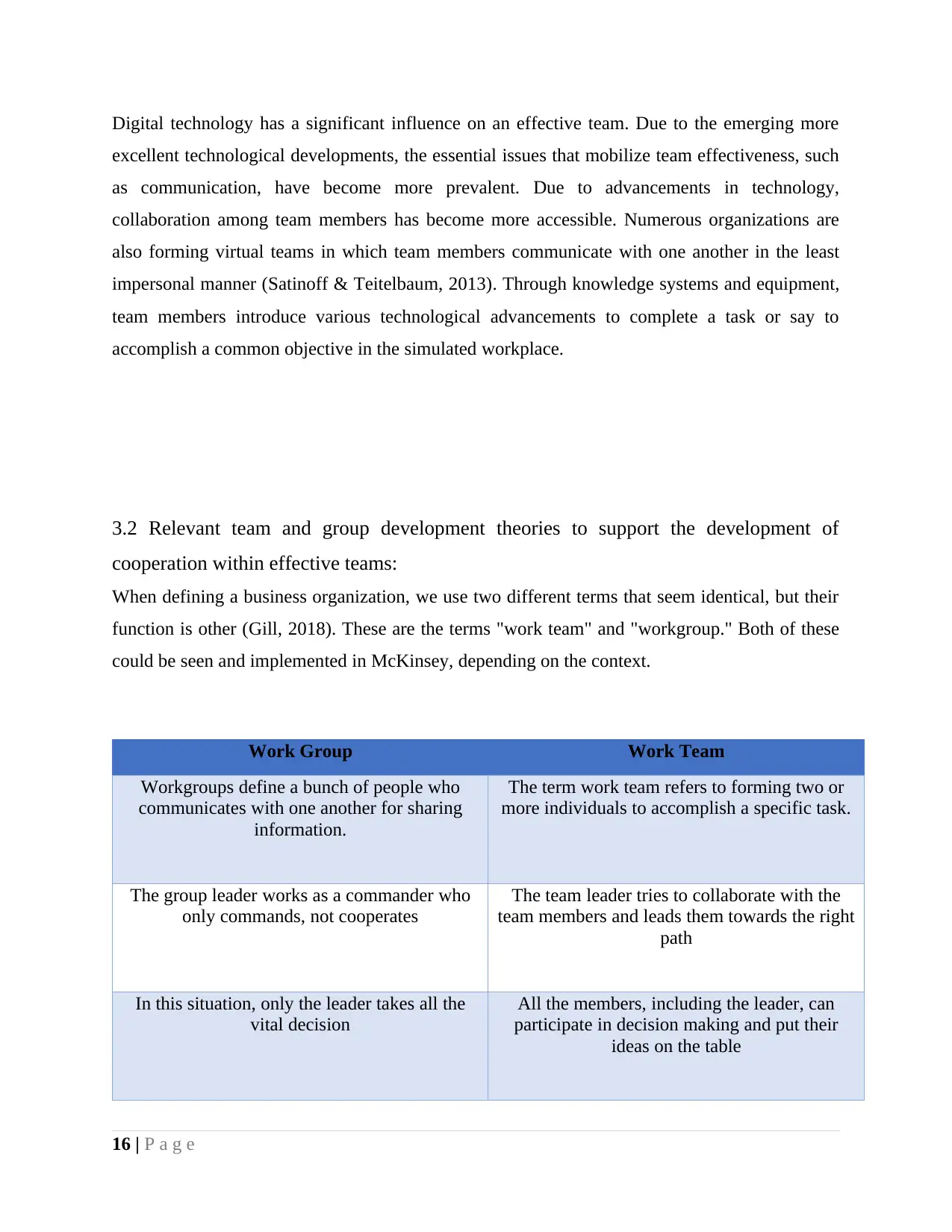
Digital technology has a significant influence on an effective team. Due to the emerging more
excellent technological developments, the essential issues that mobilize team effectiveness, such
as communication, have become more prevalent. Due to advancements in technology,
collaboration among team members has become more accessible. Numerous organizations are
also forming virtual teams in which team members communicate with one another in the least
impersonal manner (Satinoff & Teitelbaum, 2013). Through knowledge systems and equipment,
team members introduce various technological advancements to complete a task or say to
accomplish a common objective in the simulated workplace.
3.2 Relevant team and group development theories to support the development of
cooperation within effective teams:
When defining a business organization, we use two different terms that seem identical, but their
function is other (Gill, 2018). These are the terms "work team" and "workgroup." Both of these
could be seen and implemented in McKinsey, depending on the context.
Work Group Work Team
Workgroups define a bunch of people who
communicates with one another for sharing
information.
The term work team refers to forming two or
more individuals to accomplish a specific task.
The group leader works as a commander who
only commands, not cooperates
The team leader tries to collaborate with the
team members and leads them towards the right
path
In this situation, only the leader takes all the
vital decision
All the members, including the leader, can
participate in decision making and put their
ideas on the table
16 | P a g e
excellent technological developments, the essential issues that mobilize team effectiveness, such
as communication, have become more prevalent. Due to advancements in technology,
collaboration among team members has become more accessible. Numerous organizations are
also forming virtual teams in which team members communicate with one another in the least
impersonal manner (Satinoff & Teitelbaum, 2013). Through knowledge systems and equipment,
team members introduce various technological advancements to complete a task or say to
accomplish a common objective in the simulated workplace.
3.2 Relevant team and group development theories to support the development of
cooperation within effective teams:
When defining a business organization, we use two different terms that seem identical, but their
function is other (Gill, 2018). These are the terms "work team" and "workgroup." Both of these
could be seen and implemented in McKinsey, depending on the context.
Work Group Work Team
Workgroups define a bunch of people who
communicates with one another for sharing
information.
The term work team refers to forming two or
more individuals to accomplish a specific task.
The group leader works as a commander who
only commands, not cooperates
The team leader tries to collaborate with the
team members and leads them towards the right
path
In this situation, only the leader takes all the
vital decision
All the members, including the leader, can
participate in decision making and put their
ideas on the table
16 | P a g e
Secure Best Marks with AI Grader
Need help grading? Try our AI Grader for instant feedback on your assignments.
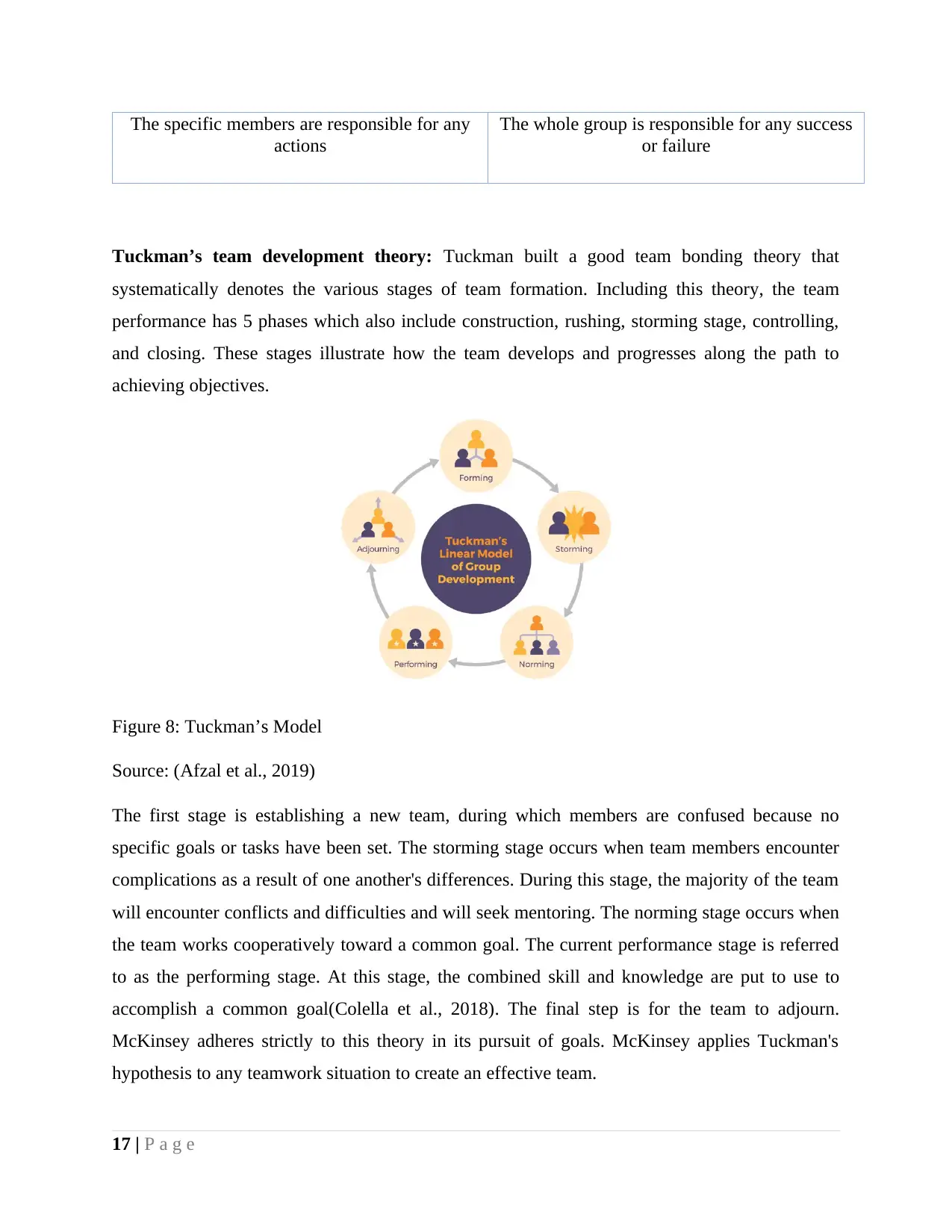
The specific members are responsible for any
actions
The whole group is responsible for any success
or failure
Tuckman’s team development theory: Tuckman built a good team bonding theory that
systematically denotes the various stages of team formation. Including this theory, the team
performance has 5 phases which also include construction, rushing, storming stage, controlling,
and closing. These stages illustrate how the team develops and progresses along the path to
achieving objectives.
Figure 8: Tuckman’s Model
Source: (Afzal et al., 2019)
The first stage is establishing a new team, during which members are confused because no
specific goals or tasks have been set. The storming stage occurs when team members encounter
complications as a result of one another's differences. During this stage, the majority of the team
will encounter conflicts and difficulties and will seek mentoring. The norming stage occurs when
the team works cooperatively toward a common goal. The current performance stage is referred
to as the performing stage. At this stage, the combined skill and knowledge are put to use to
accomplish a common goal(Colella et al., 2018). The final step is for the team to adjourn.
McKinsey adheres strictly to this theory in its pursuit of goals. McKinsey applies Tuckman's
hypothesis to any teamwork situation to create an effective team.
17 | P a g e
actions
The whole group is responsible for any success
or failure
Tuckman’s team development theory: Tuckman built a good team bonding theory that
systematically denotes the various stages of team formation. Including this theory, the team
performance has 5 phases which also include construction, rushing, storming stage, controlling,
and closing. These stages illustrate how the team develops and progresses along the path to
achieving objectives.
Figure 8: Tuckman’s Model
Source: (Afzal et al., 2019)
The first stage is establishing a new team, during which members are confused because no
specific goals or tasks have been set. The storming stage occurs when team members encounter
complications as a result of one another's differences. During this stage, the majority of the team
will encounter conflicts and difficulties and will seek mentoring. The norming stage occurs when
the team works cooperatively toward a common goal. The current performance stage is referred
to as the performing stage. At this stage, the combined skill and knowledge are put to use to
accomplish a common goal(Colella et al., 2018). The final step is for the team to adjourn.
McKinsey adheres strictly to this theory in its pursuit of goals. McKinsey applies Tuckman's
hypothesis to any teamwork situation to create an effective team.
17 | P a g e
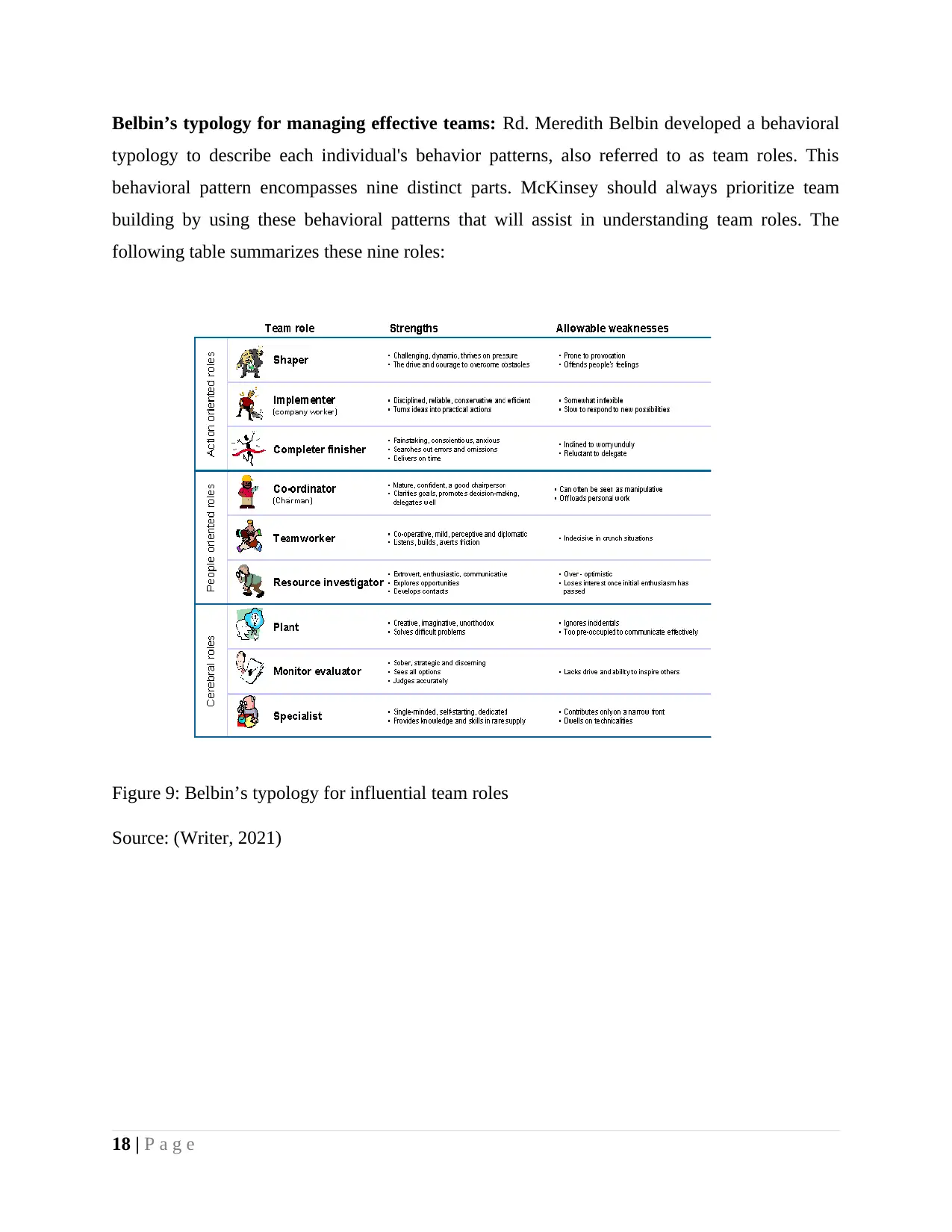
Belbin’s typology for managing effective teams: Rd. Meredith Belbin developed a behavioral
typology to describe each individual's behavior patterns, also referred to as team roles. This
behavioral pattern encompasses nine distinct parts. McKinsey should always prioritize team
building by using these behavioral patterns that will assist in understanding team roles. The
following table summarizes these nine roles:
Figure 9: Belbin’s typology for influential team roles
Source: (Writer, 2021)
18 | P a g e
typology to describe each individual's behavior patterns, also referred to as team roles. This
behavioral pattern encompasses nine distinct parts. McKinsey should always prioritize team
building by using these behavioral patterns that will assist in understanding team roles. The
following table summarizes these nine roles:
Figure 9: Belbin’s typology for influential team roles
Source: (Writer, 2021)
18 | P a g e
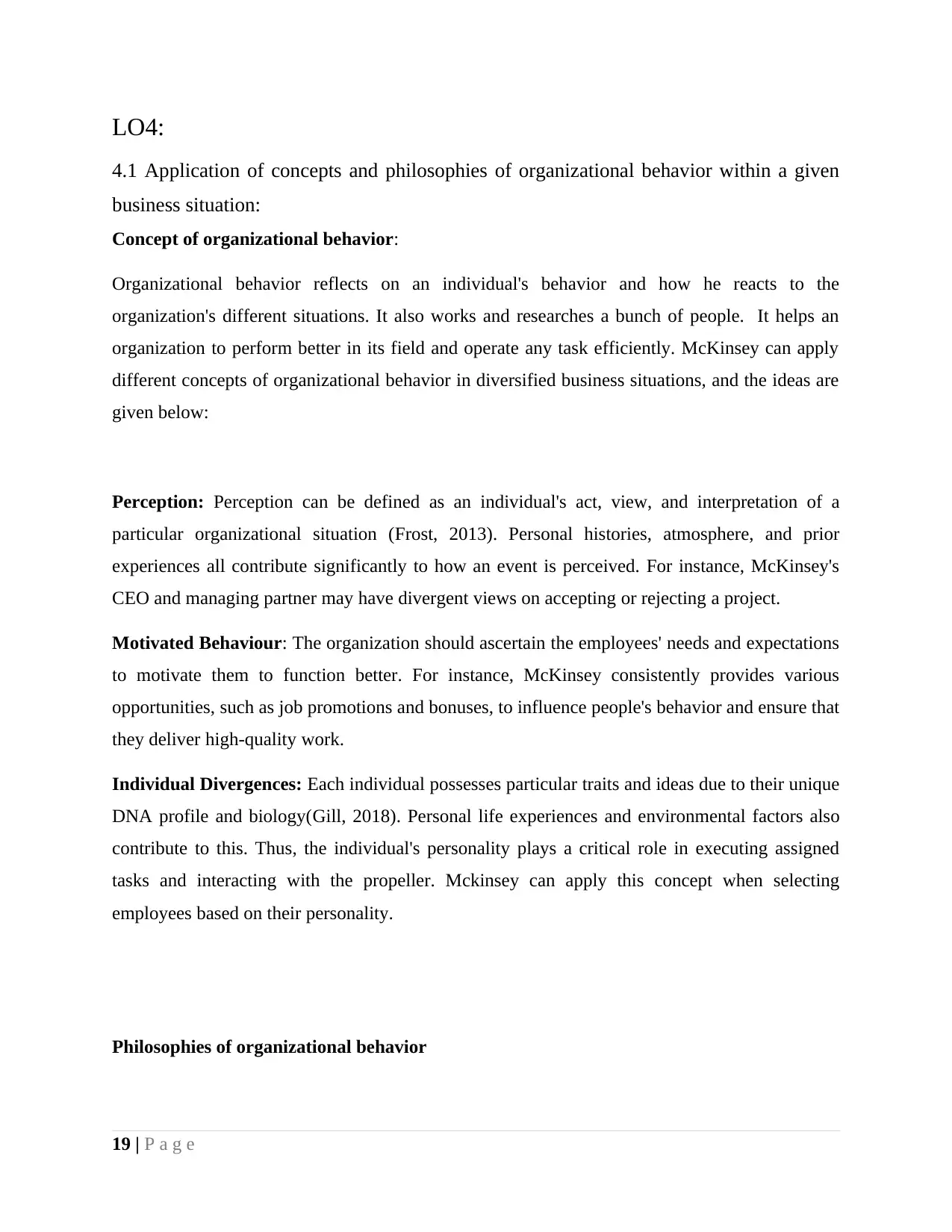
LO4:
4.1 Application of concepts and philosophies of organizational behavior within a given
business situation:
Concept of organizational behavior:
Organizational behavior reflects on an individual's behavior and how he reacts to the
organization's different situations. It also works and researches a bunch of people. It helps an
organization to perform better in its field and operate any task efficiently. McKinsey can apply
different concepts of organizational behavior in diversified business situations, and the ideas are
given below:
Perception: Perception can be defined as an individual's act, view, and interpretation of a
particular organizational situation (Frost, 2013). Personal histories, atmosphere, and prior
experiences all contribute significantly to how an event is perceived. For instance, McKinsey's
CEO and managing partner may have divergent views on accepting or rejecting a project.
Motivated Behaviour: The organization should ascertain the employees' needs and expectations
to motivate them to function better. For instance, McKinsey consistently provides various
opportunities, such as job promotions and bonuses, to influence people's behavior and ensure that
they deliver high-quality work.
Individual Divergences: Each individual possesses particular traits and ideas due to their unique
DNA profile and biology(Gill, 2018). Personal life experiences and environmental factors also
contribute to this. Thus, the individual's personality plays a critical role in executing assigned
tasks and interacting with the propeller. Mckinsey can apply this concept when selecting
employees based on their personality.
Philosophies of organizational behavior
19 | P a g e
4.1 Application of concepts and philosophies of organizational behavior within a given
business situation:
Concept of organizational behavior:
Organizational behavior reflects on an individual's behavior and how he reacts to the
organization's different situations. It also works and researches a bunch of people. It helps an
organization to perform better in its field and operate any task efficiently. McKinsey can apply
different concepts of organizational behavior in diversified business situations, and the ideas are
given below:
Perception: Perception can be defined as an individual's act, view, and interpretation of a
particular organizational situation (Frost, 2013). Personal histories, atmosphere, and prior
experiences all contribute significantly to how an event is perceived. For instance, McKinsey's
CEO and managing partner may have divergent views on accepting or rejecting a project.
Motivated Behaviour: The organization should ascertain the employees' needs and expectations
to motivate them to function better. For instance, McKinsey consistently provides various
opportunities, such as job promotions and bonuses, to influence people's behavior and ensure that
they deliver high-quality work.
Individual Divergences: Each individual possesses particular traits and ideas due to their unique
DNA profile and biology(Gill, 2018). Personal life experiences and environmental factors also
contribute to this. Thus, the individual's personality plays a critical role in executing assigned
tasks and interacting with the propeller. Mckinsey can apply this concept when selecting
employees based on their personality.
Philosophies of organizational behavior
19 | P a g e
Paraphrase This Document
Need a fresh take? Get an instant paraphrase of this document with our AI Paraphraser
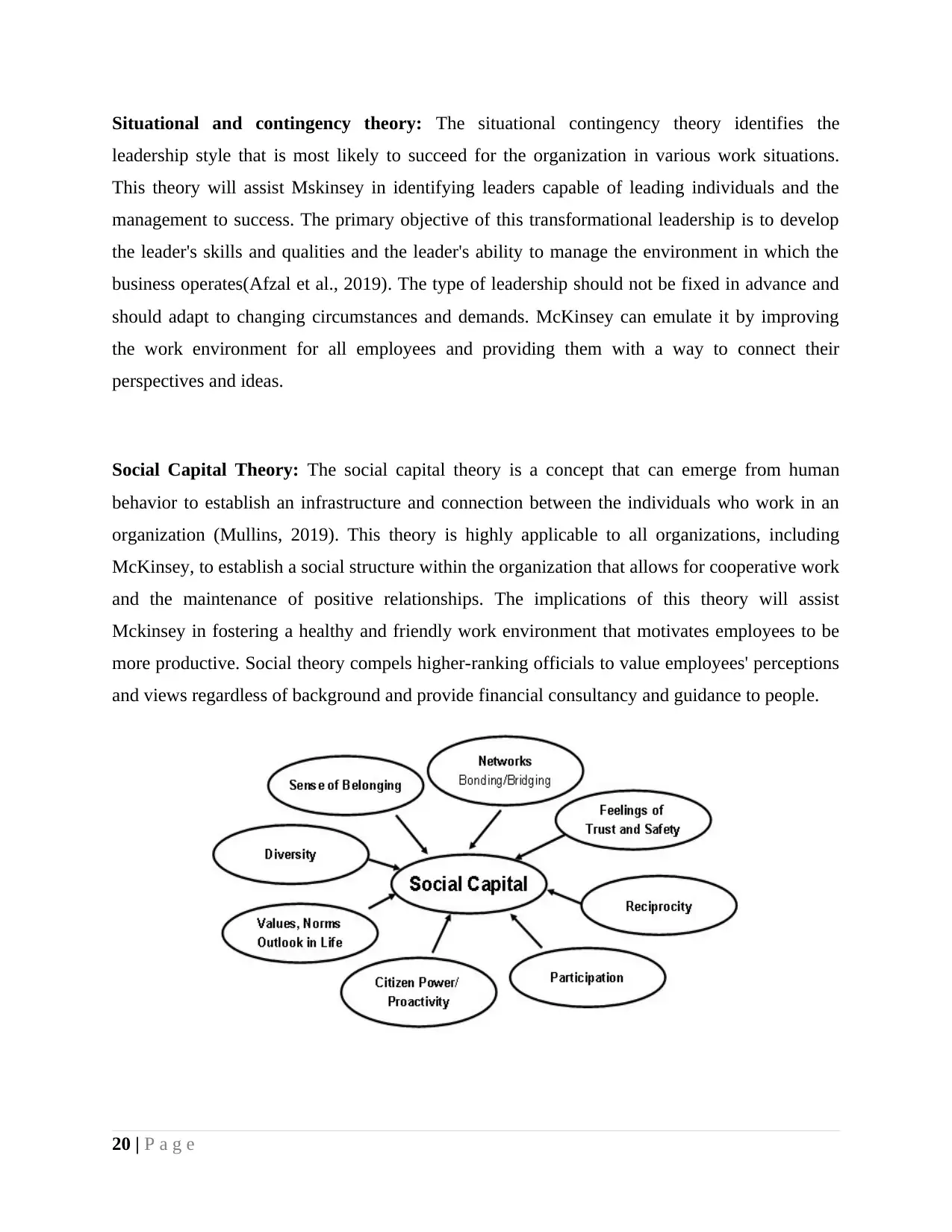
Situational and contingency theory: The situational contingency theory identifies the
leadership style that is most likely to succeed for the organization in various work situations.
This theory will assist Mskinsey in identifying leaders capable of leading individuals and the
management to success. The primary objective of this transformational leadership is to develop
the leader's skills and qualities and the leader's ability to manage the environment in which the
business operates(Afzal et al., 2019). The type of leadership should not be fixed in advance and
should adapt to changing circumstances and demands. McKinsey can emulate it by improving
the work environment for all employees and providing them with a way to connect their
perspectives and ideas.
Social Capital Theory: The social capital theory is a concept that can emerge from human
behavior to establish an infrastructure and connection between the individuals who work in an
organization (Mullins, 2019). This theory is highly applicable to all organizations, including
McKinsey, to establish a social structure within the organization that allows for cooperative work
and the maintenance of positive relationships. The implications of this theory will assist
Mckinsey in fostering a healthy and friendly work environment that motivates employees to be
more productive. Social theory compels higher-ranking officials to value employees' perceptions
and views regardless of background and provide financial consultancy and guidance to people.
20 | P a g e
leadership style that is most likely to succeed for the organization in various work situations.
This theory will assist Mskinsey in identifying leaders capable of leading individuals and the
management to success. The primary objective of this transformational leadership is to develop
the leader's skills and qualities and the leader's ability to manage the environment in which the
business operates(Afzal et al., 2019). The type of leadership should not be fixed in advance and
should adapt to changing circumstances and demands. McKinsey can emulate it by improving
the work environment for all employees and providing them with a way to connect their
perspectives and ideas.
Social Capital Theory: The social capital theory is a concept that can emerge from human
behavior to establish an infrastructure and connection between the individuals who work in an
organization (Mullins, 2019). This theory is highly applicable to all organizations, including
McKinsey, to establish a social structure within the organization that allows for cooperative work
and the maintenance of positive relationships. The implications of this theory will assist
Mckinsey in fostering a healthy and friendly work environment that motivates employees to be
more productive. Social theory compels higher-ranking officials to value employees' perceptions
and views regardless of background and provide financial consultancy and guidance to people.
20 | P a g e

Figure 10: Social capital theory
Source: (Bhasin, 2021)
4.2 How concepts and philosophies of OB inform and influence behavior within a given
business situation:
Organizational behavior encompasses various theories and models that assist the organization's
manager in coping with and influencing the organization's behavior (Natvig & Stark, 2016). The
approaches have the potential to have a positive or negative effect on individual behavior within
the organization. Organizational commitment can have the following impact on the behavior of a
McKinsey employee:
Scientific management approach: Scientific theories assist the organization in conducting a
scientific analysis of each of its activities and functions. The hypothesis can provide a
recommended teaching method to McKinsey employees, which can aid in their training and
selection. Additionally, it involves developing individuals for them to become more efficient at
carrying out organizational tasks economically. The adverse effect of a scientific theory is that it
does not adequately value the employee's efforts and understanding and increases its reliance on
the machine.
Bureaucratic Approach: Bureaucratic approaches emphasize management structure rather than
the interaction between assignment and employee (Frost, 2013). This theory will aid McKinsey
in establishing an effective organizational structure in which job responsibilities for each
employee are divided according to worker efficiency. The drawback of this system is that it
results in inefficient worker skills and team unity. The theory centralized authority and strength
from the top to the lower officials, constraining employees' ability to work cooperatively, thus
allowing for goal attainment displacement.
21 | P a g e
Source: (Bhasin, 2021)
4.2 How concepts and philosophies of OB inform and influence behavior within a given
business situation:
Organizational behavior encompasses various theories and models that assist the organization's
manager in coping with and influencing the organization's behavior (Natvig & Stark, 2016). The
approaches have the potential to have a positive or negative effect on individual behavior within
the organization. Organizational commitment can have the following impact on the behavior of a
McKinsey employee:
Scientific management approach: Scientific theories assist the organization in conducting a
scientific analysis of each of its activities and functions. The hypothesis can provide a
recommended teaching method to McKinsey employees, which can aid in their training and
selection. Additionally, it involves developing individuals for them to become more efficient at
carrying out organizational tasks economically. The adverse effect of a scientific theory is that it
does not adequately value the employee's efforts and understanding and increases its reliance on
the machine.
Bureaucratic Approach: Bureaucratic approaches emphasize management structure rather than
the interaction between assignment and employee (Frost, 2013). This theory will aid McKinsey
in establishing an effective organizational structure in which job responsibilities for each
employee are divided according to worker efficiency. The drawback of this system is that it
results in inefficient worker skills and team unity. The theory centralized authority and strength
from the top to the lower officials, constraining employees' ability to work cooperatively, thus
allowing for goal attainment displacement.
21 | P a g e
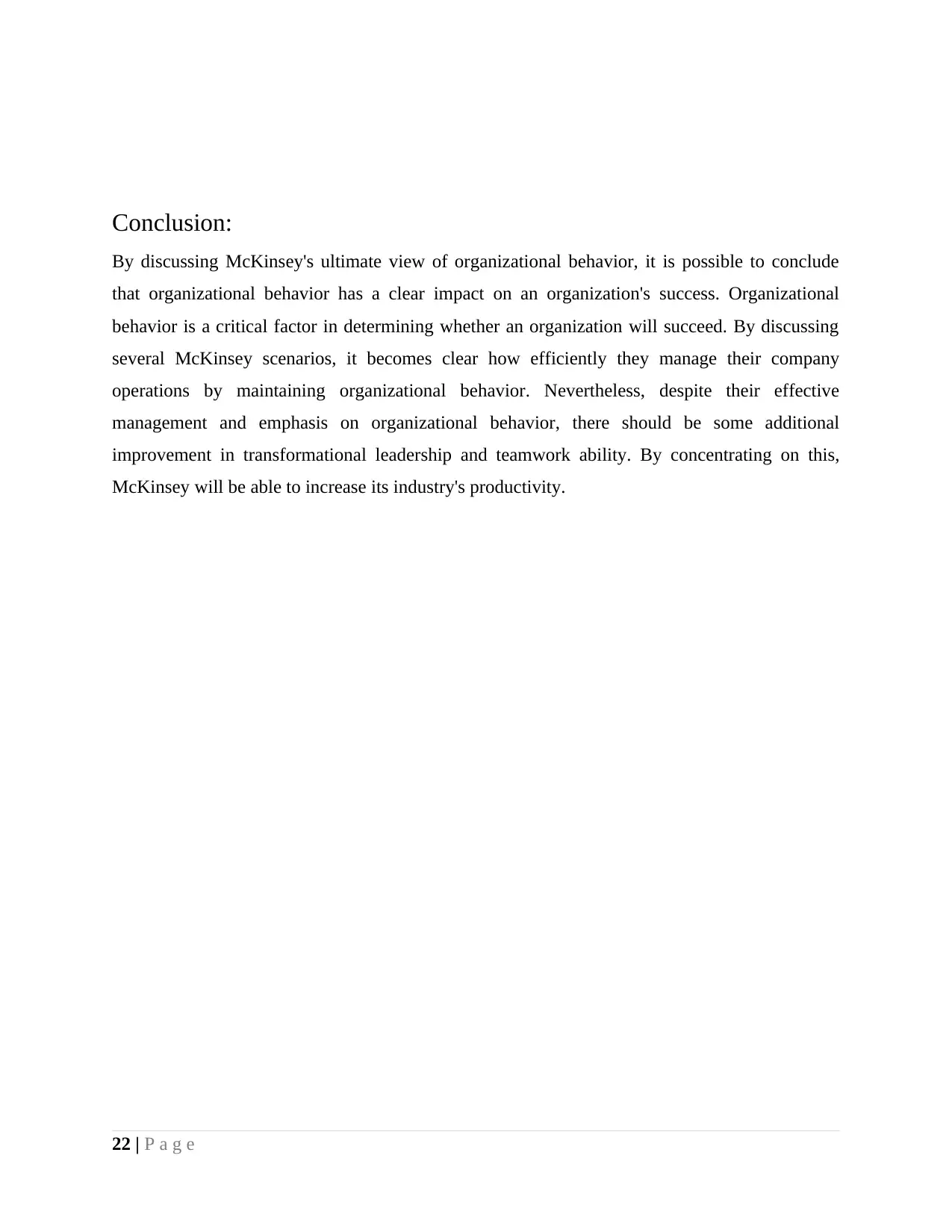
Conclusion:
By discussing McKinsey's ultimate view of organizational behavior, it is possible to conclude
that organizational behavior has a clear impact on an organization's success. Organizational
behavior is a critical factor in determining whether an organization will succeed. By discussing
several McKinsey scenarios, it becomes clear how efficiently they manage their company
operations by maintaining organizational behavior. Nevertheless, despite their effective
management and emphasis on organizational behavior, there should be some additional
improvement in transformational leadership and teamwork ability. By concentrating on this,
McKinsey will be able to increase its industry's productivity.
22 | P a g e
By discussing McKinsey's ultimate view of organizational behavior, it is possible to conclude
that organizational behavior has a clear impact on an organization's success. Organizational
behavior is a critical factor in determining whether an organization will succeed. By discussing
several McKinsey scenarios, it becomes clear how efficiently they manage their company
operations by maintaining organizational behavior. Nevertheless, despite their effective
management and emphasis on organizational behavior, there should be some additional
improvement in transformational leadership and teamwork ability. By concentrating on this,
McKinsey will be able to increase its industry's productivity.
22 | P a g e
Secure Best Marks with AI Grader
Need help grading? Try our AI Grader for instant feedback on your assignments.
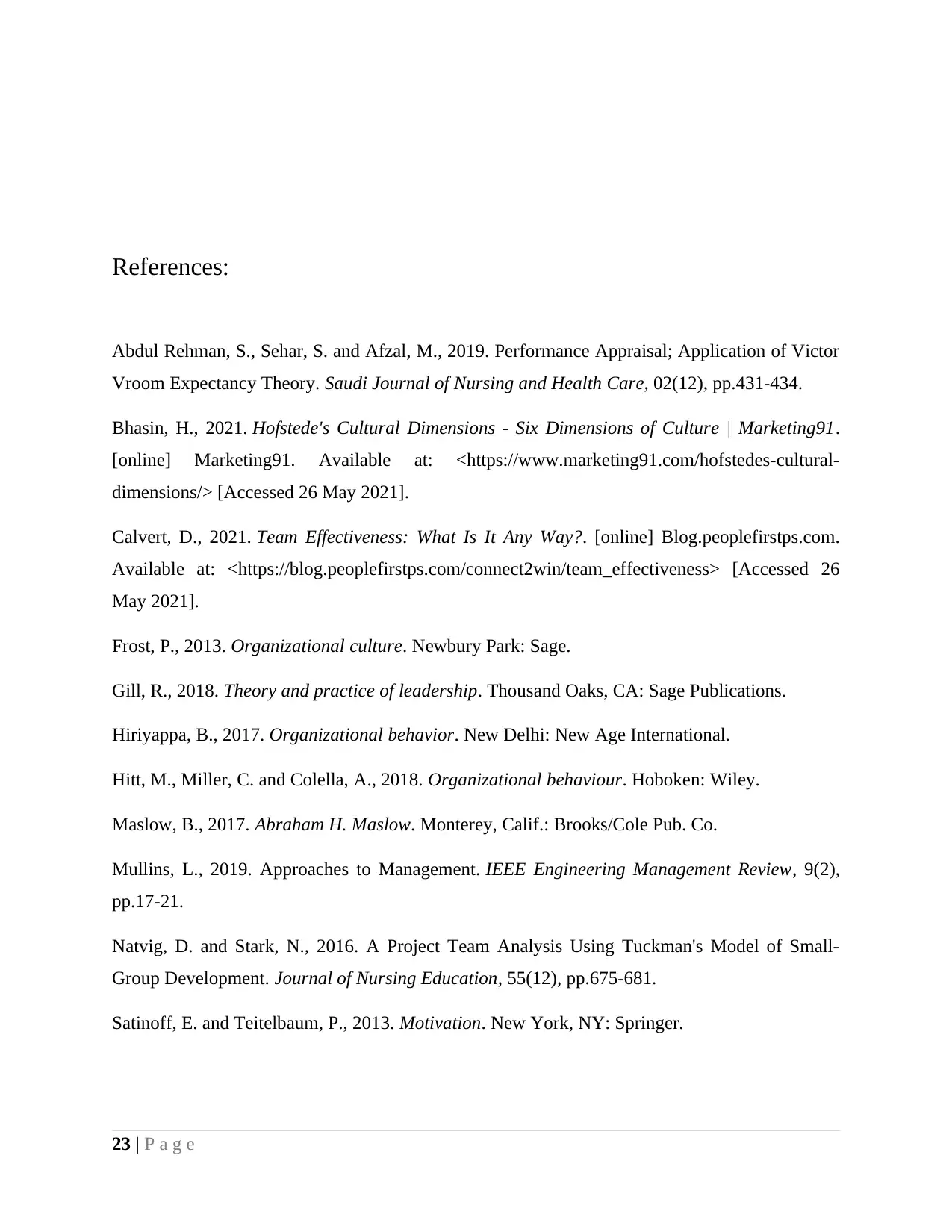
References:
Abdul Rehman, S., Sehar, S. and Afzal, M., 2019. Performance Appraisal; Application of Victor
Vroom Expectancy Theory. Saudi Journal of Nursing and Health Care, 02(12), pp.431-434.
Bhasin, H., 2021. Hofstede's Cultural Dimensions - Six Dimensions of Culture | Marketing91.
[online] Marketing91. Available at: <https://www.marketing91.com/hofstedes-cultural-
dimensions/> [Accessed 26 May 2021].
Calvert, D., 2021. Team Effectiveness: What Is It Any Way?. [online] Blog.peoplefirstps.com.
Available at: <https://blog.peoplefirstps.com/connect2win/team_effectiveness> [Accessed 26
May 2021].
Frost, P., 2013. Organizational culture. Newbury Park: Sage.
Gill, R., 2018. Theory and practice of leadership. Thousand Oaks, CA: Sage Publications.
Hiriyappa, B., 2017. Organizational behavior. New Delhi: New Age International.
Hitt, M., Miller, C. and Colella, A., 2018. Organizational behaviour. Hoboken: Wiley.
Maslow, B., 2017. Abraham H. Maslow. Monterey, Calif.: Brooks/Cole Pub. Co.
Mullins, L., 2019. Approaches to Management. IEEE Engineering Management Review, 9(2),
pp.17-21.
Natvig, D. and Stark, N., 2016. A Project Team Analysis Using Tuckman's Model of Small-
Group Development. Journal of Nursing Education, 55(12), pp.675-681.
Satinoff, E. and Teitelbaum, P., 2013. Motivation. New York, NY: Springer.
23 | P a g e
Abdul Rehman, S., Sehar, S. and Afzal, M., 2019. Performance Appraisal; Application of Victor
Vroom Expectancy Theory. Saudi Journal of Nursing and Health Care, 02(12), pp.431-434.
Bhasin, H., 2021. Hofstede's Cultural Dimensions - Six Dimensions of Culture | Marketing91.
[online] Marketing91. Available at: <https://www.marketing91.com/hofstedes-cultural-
dimensions/> [Accessed 26 May 2021].
Calvert, D., 2021. Team Effectiveness: What Is It Any Way?. [online] Blog.peoplefirstps.com.
Available at: <https://blog.peoplefirstps.com/connect2win/team_effectiveness> [Accessed 26
May 2021].
Frost, P., 2013. Organizational culture. Newbury Park: Sage.
Gill, R., 2018. Theory and practice of leadership. Thousand Oaks, CA: Sage Publications.
Hiriyappa, B., 2017. Organizational behavior. New Delhi: New Age International.
Hitt, M., Miller, C. and Colella, A., 2018. Organizational behaviour. Hoboken: Wiley.
Maslow, B., 2017. Abraham H. Maslow. Monterey, Calif.: Brooks/Cole Pub. Co.
Mullins, L., 2019. Approaches to Management. IEEE Engineering Management Review, 9(2),
pp.17-21.
Natvig, D. and Stark, N., 2016. A Project Team Analysis Using Tuckman's Model of Small-
Group Development. Journal of Nursing Education, 55(12), pp.675-681.
Satinoff, E. and Teitelbaum, P., 2013. Motivation. New York, NY: Springer.
23 | P a g e
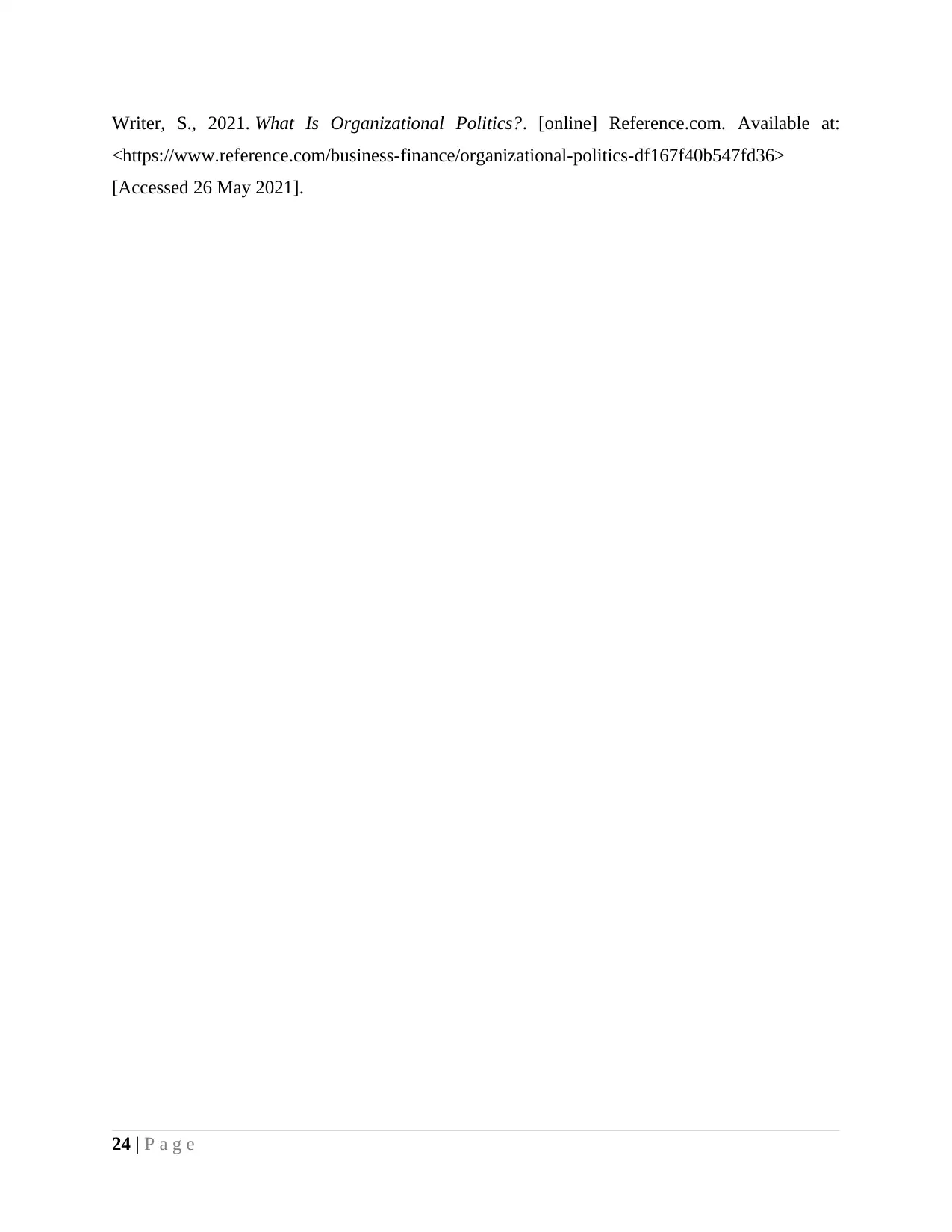
Writer, S., 2021. What Is Organizational Politics?. [online] Reference.com. Available at:
<https://www.reference.com/business-finance/organizational-politics-df167f40b547fd36>
[Accessed 26 May 2021].
24 | P a g e
<https://www.reference.com/business-finance/organizational-politics-df167f40b547fd36>
[Accessed 26 May 2021].
24 | P a g e
1 out of 24
Related Documents
Your All-in-One AI-Powered Toolkit for Academic Success.
+13062052269
info@desklib.com
Available 24*7 on WhatsApp / Email
![[object Object]](/_next/static/media/star-bottom.7253800d.svg)
Unlock your academic potential
© 2024 | Zucol Services PVT LTD | All rights reserved.





